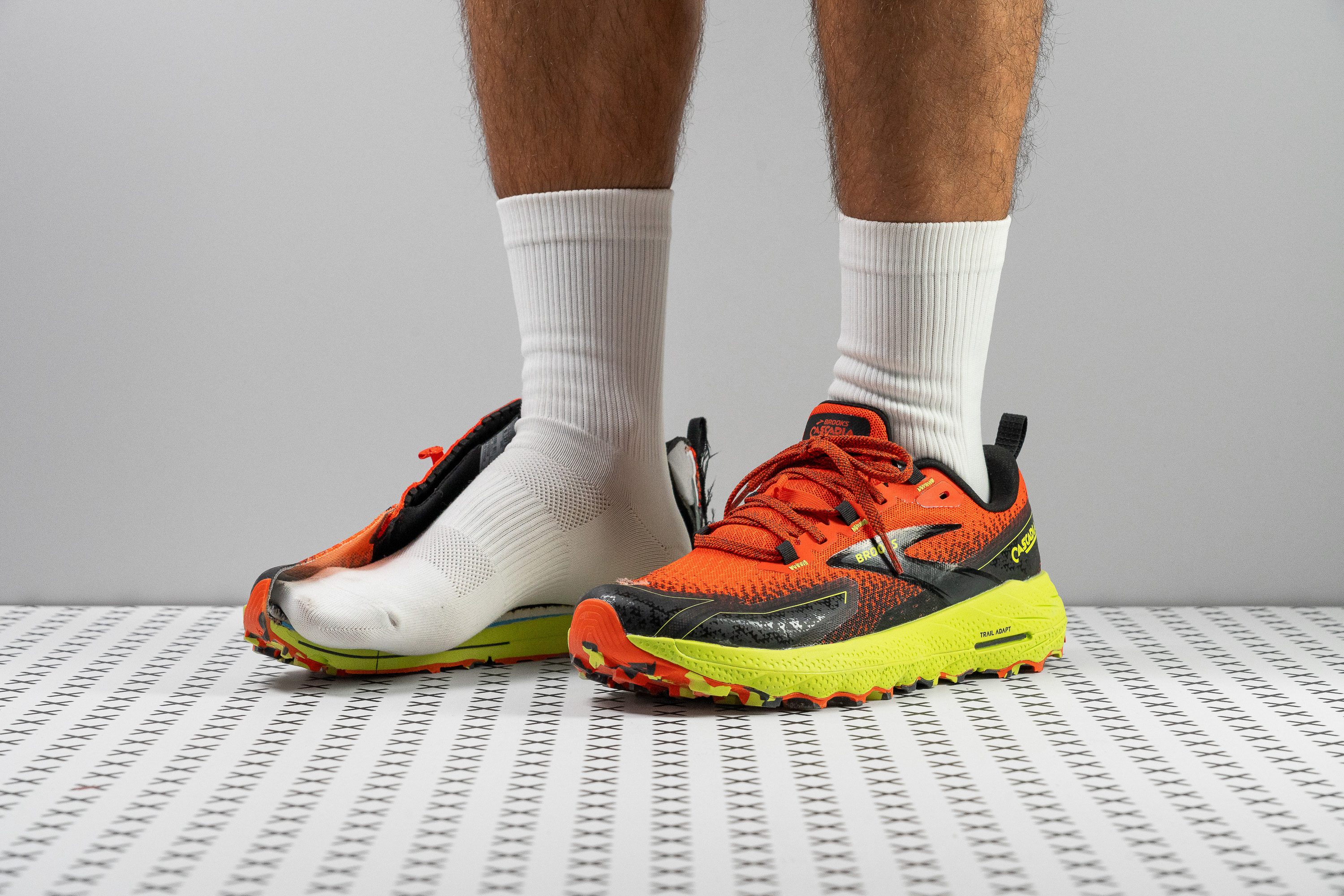Our verdict
- Top pick in best Brooks trail running shoes (2024)
Pros
- Breathable upper
- Great value for the price
- Stability-enhancing Trail Adapt plate
- Good grip
- Amazing tongue
- Doubles well as a hiking shoe
- Fits most foot shapes
- Velcro strap for gaiter attachment
- Designed with heel strikers in mind
Cons
- Noticeable durability issues
- Midsole lacks bounce and softness
- Still on the heavier side
- No reflective elements
Audience verdict
Comparison
The most similar running shoes compared
+ + Add a shoe | |||||
|---|---|---|---|---|---|
| Audience score | 86 Good! | 74 Bad! | 83 Good! | 86 Good! | |
| Price | £140 | £100 | £135 | £140 | |
| Trail terrain | LightModerate | Light | Moderate | LightModerate | |
| Shock absorption | Low | - | - | Moderate | |
| Energy return | Low | - | - | Moderate | |
| Traction | - | - | - | High | |
| Arch support | Neutral | Neutral | Neutral | Neutral | |
| Weight lab Weight brand | 10.9 oz / 310g 11.1 oz / 314g | 11 oz / 312g 11.5 oz / 326g | 9.6 oz / 271g 9.5 oz / 270g | 10.8 oz / 306g 10.7 oz / 303g | |
| Drop lab Drop brand | 8.8 mm 8.0 mm | 8.2 mm | 8.9 mm 6.0 mm | 7.8 mm 6.0 mm | |
| Strike pattern | HeelMid/forefoot | HeelMid/forefoot | HeelMid/forefoot | Mid/forefoot | |
| Size | True to size | True to size | Half size small | True to size | |
| Midsole softness | Balanced | Balanced | Soft | Balanced | |
| Difference in midsole softness in cold | Small | Small | Normal | Normal | |
| Plate | Rock plate | ✗ | ✗ | Rock plate | |
| Toebox durability | Very bad | Decent | Very bad | Good | |
| Heel padding durability | Decent | Bad | Bad | Decent | |
| Outsole durability | Decent | Good | Decent | Good | |
| Breathability | Moderate | Moderate | Moderate | Moderate | |
| Width / fit | Medium | Narrow | Medium | Medium | |
| Toebox width | Medium | Medium | Medium | Medium | |
| Stiffness | Stiff | Stiff | Stiff | Moderate | |
| Torsional rigidity | Stiff | Moderate | Stiff | Stiff | |
| Heel counter stiffness | Stiff | Moderate | Stiff | Stiff | |
| Lug depth | 4.0 mm | 2.9 mm | 3.4 mm | 3.8 mm | |
| Heel stack lab Heel stack brand | 32.6 mm 33.0 mm | 33.8 mm | 29.3 mm 34.0 mm | 34.8 mm 35.0 mm | |
| Forefoot lab Forefoot brand | 23.8 mm 25.0 mm | 25.6 mm | 20.4 mm 28.0 mm | 27.0 mm 29.0 mm | |
| Widths available | NormalWide | NormalWideX-Wide | Normal | NormalWide | |
| For heavy runners | ✗ | ✗ | ✗ | ✓ | |
| Season | All seasons | All seasons | All seasons | All seasons | |
| Removable insole | ✓ | ✓ | ✓ | ✓ | |
| Orthotic friendly | ✓ | ✓ | ✓ | ✓ | |
| Ranking | #395 Bottom 40% | #362 Bottom 3% | #267 Bottom 28% | #198 Bottom 47% | |
| Popularity | #255 Top 39% | #312 Bottom 16% | #199 Bottom 46% | #111 Top 30% |
Who should buy
We think the Brooks Cascadia 18 is a fantastic choice for:
- Newcomers to trail running who want a comfort-focused shoe for varied mountain activities.
- Runners prioritising a breathable upper, a rare feature in many trail shoes.
- Heel strikers looking for a stable, well-balanced ride on light or moderate terrain.
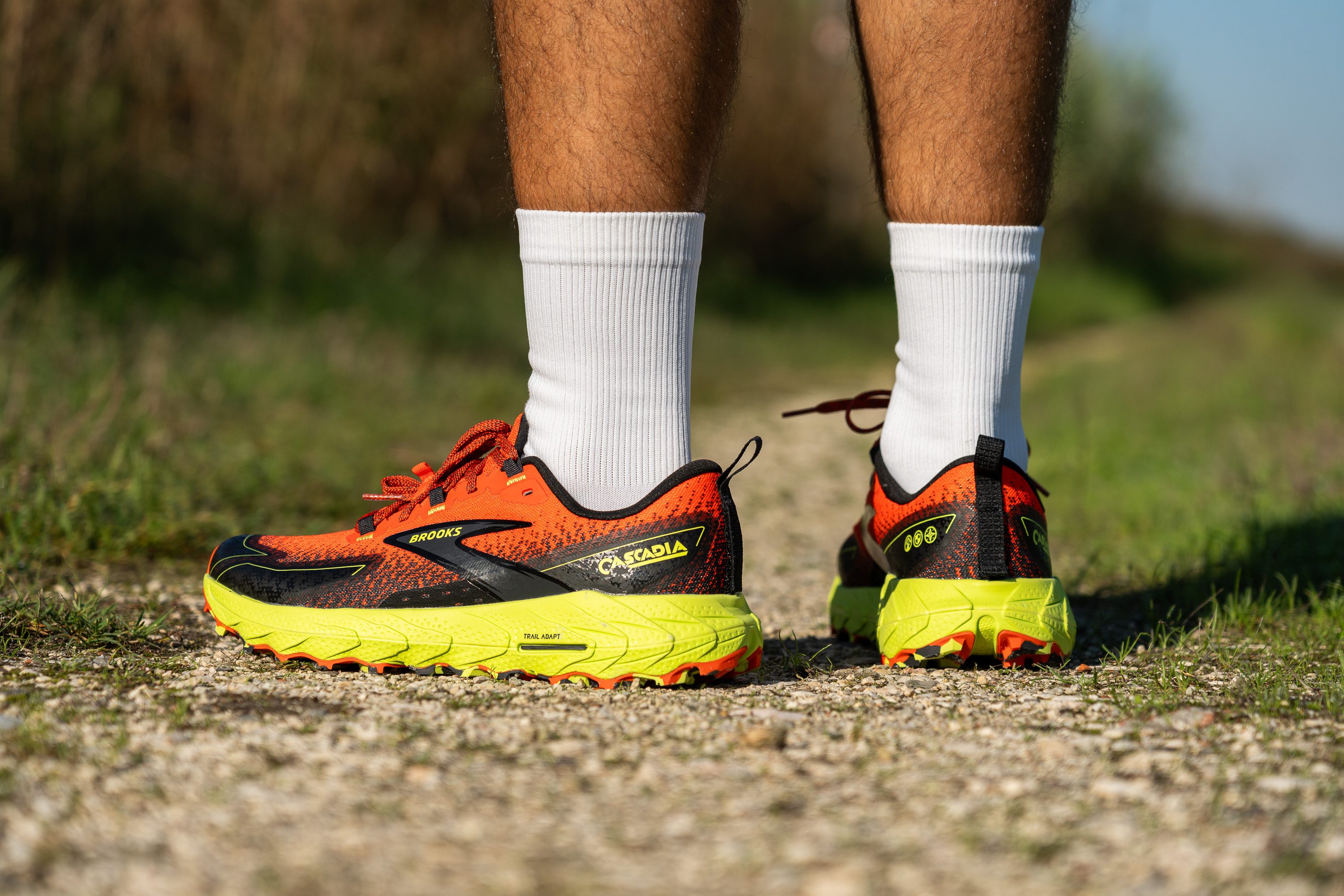
Who should NOT buy
We believe the Brooks Cascadia 18 is not the ideal choice for those seeking a cushioned, plush trail experience. With a firm midsole and a moderate stack height, it falls short for runners looking for extra cushioning. For a plush option, we recommend the Brooks Caldera 7 or Nike Zegama 2.
In our experience, durability is another area where the Cascadia 18 struggles. We observed concerning wear in the upper, making it less rugged than many trail runners expect. For those who prioritise a built-like-a-tank upper, we suggest taking a look at the Hoka Speedgoat 6, a highly durable and versatile alternative.
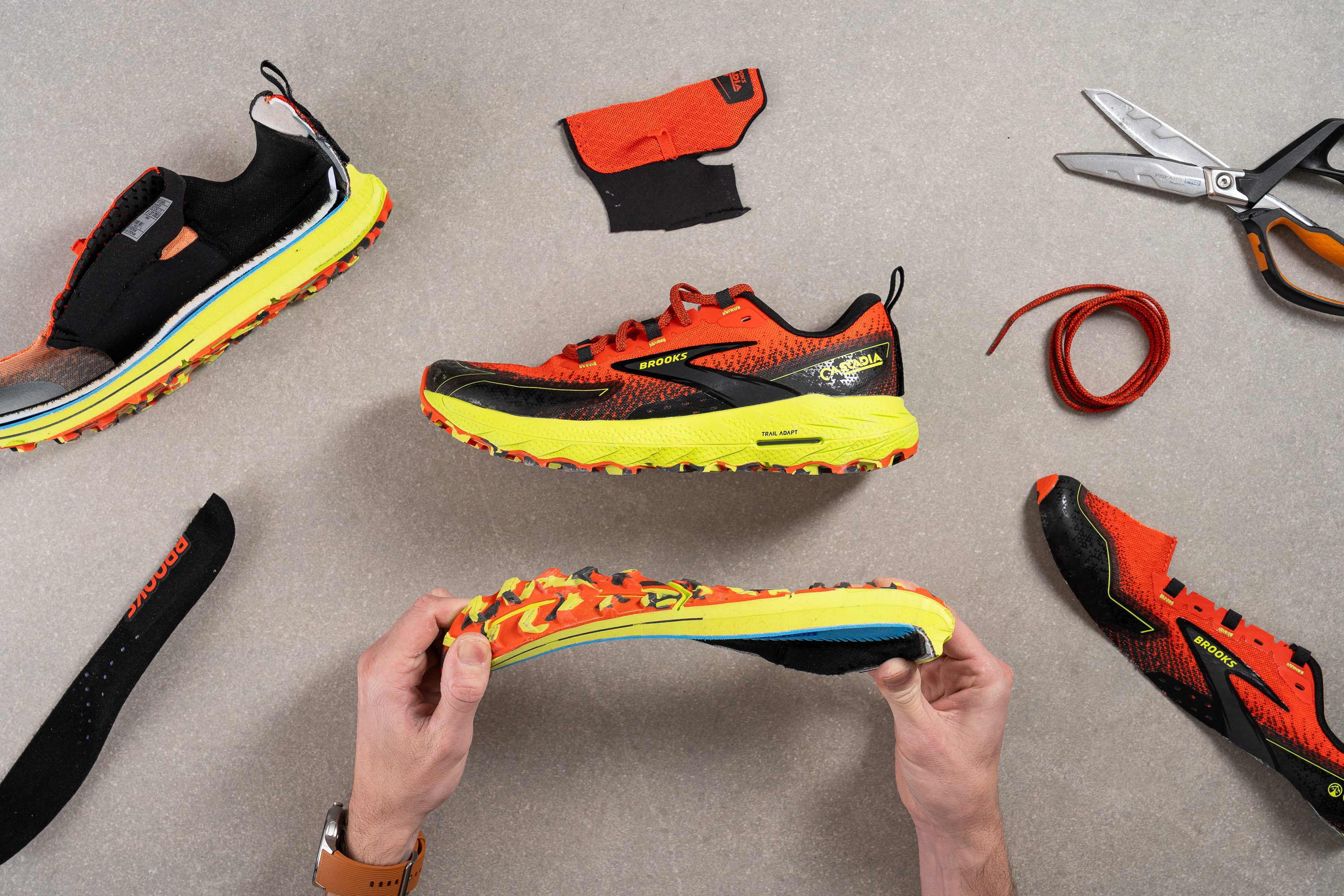
Cushioning
Shock absorption
We tested the Cascadia 18 and recorded 110 SA in the heel and just 88 SA in the forefoot—placing it in the medium-to-low range for shock absorption.
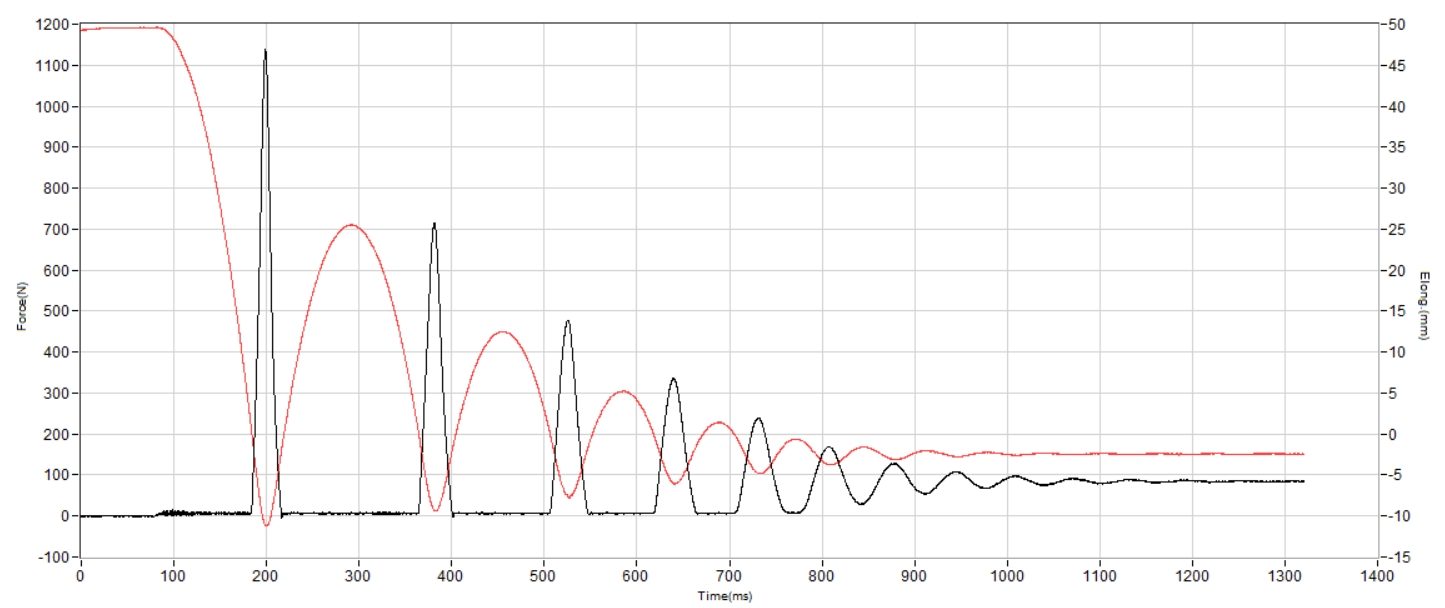
| Cascadia 18 | 110 SA |
| Average | 122 SA |
Energy return
Brooks stuck with DNA Loft v2 in the Cascadia 18, which means energy return is average at best—and that’s exactly what we measured with 54.1% in our lab test.
It’s not underwhelming and fully expected, but we believe the Cascadia 18 would greatly benefit from a slightly bouncier midsole. Maybe, after 18 versions, it’s finally time to make the leap.
| Cascadia 18 | 54.1% |
| Average | 55.6% |
Heel stack
This isn’t a towering, maximalist shoe with extreme stack height—it’s a daily-trainer-like design with 32.6 mm under the heel, which by the way, we think doesn’t quite justify its high weight. In our view, other brands have achieved more efficient weight management in this category.
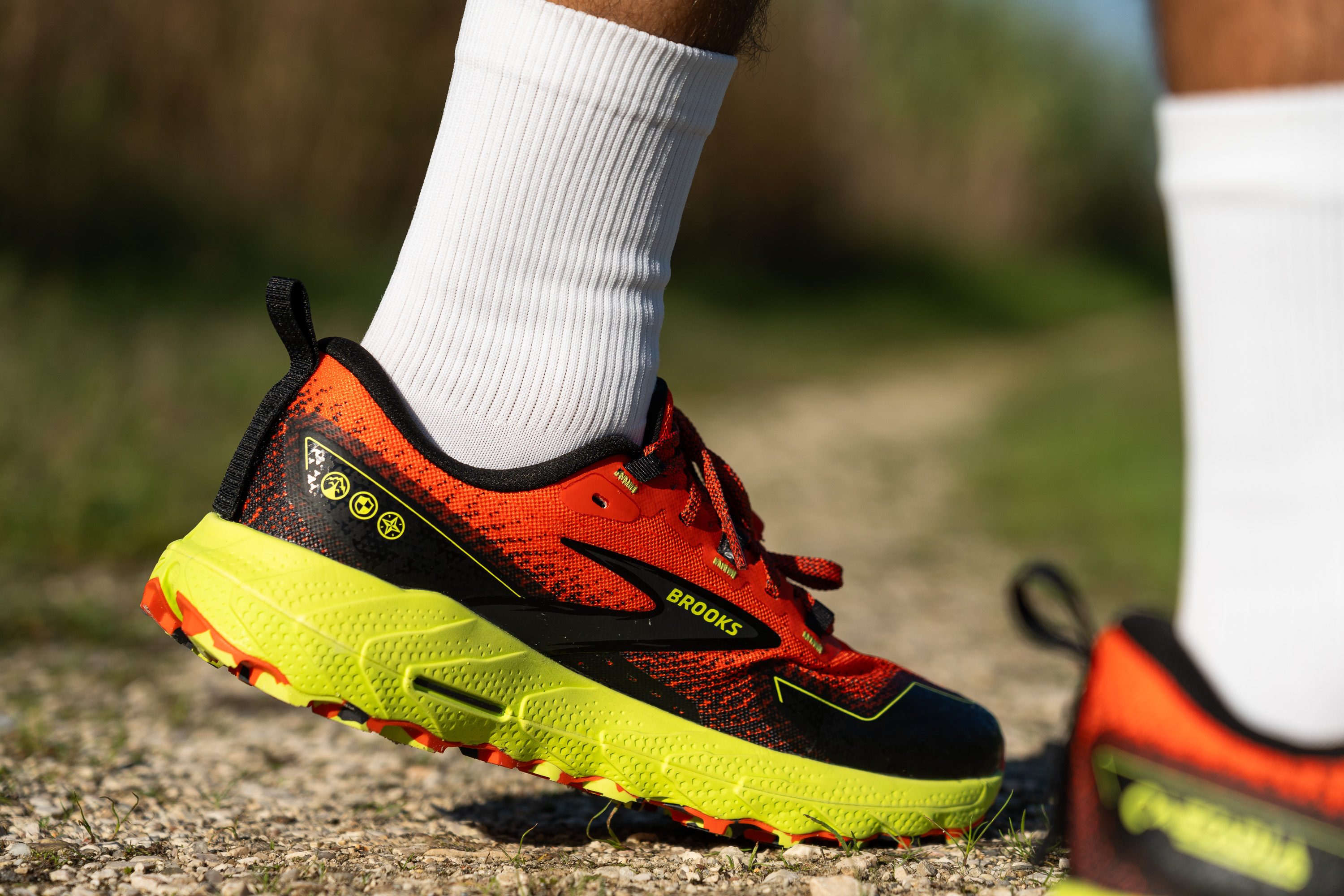
Still, this cushioning level feels just right for the Cascadia’s role, and we hope Brooks doesn’t simply trim down the stack to lighten the load. That would be a mistake.
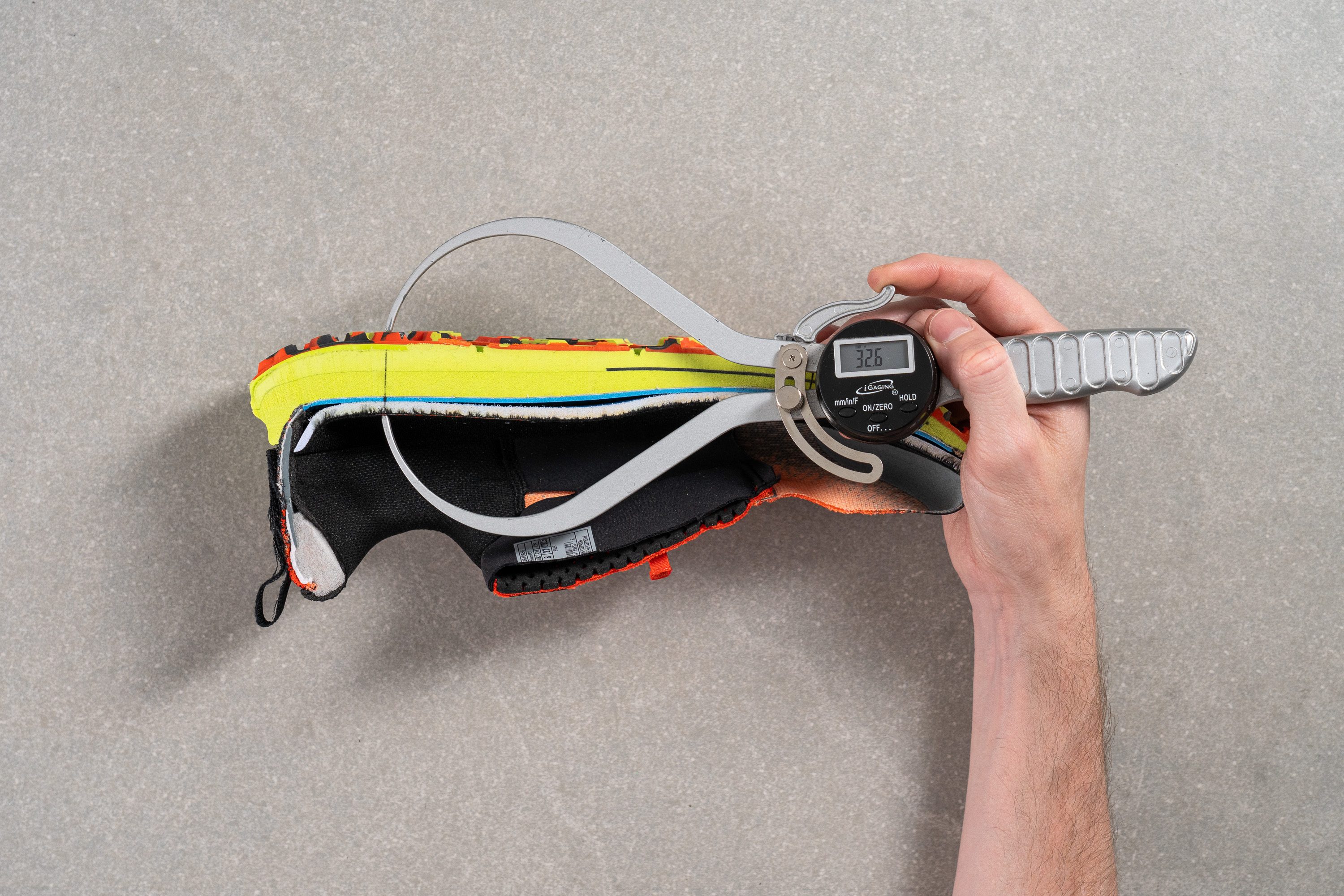
| Cascadia 18 | 32.6 mm |
| Average | 32.6 mm |
Forefoot stack
No major updates in the forefoot, which stays at 23.8 mm—probably a bit slim for runners with heavier builds. If you’re looking for extra cushion, the Altra’s Olympus 6 with its colossal 31.5-mm forefoot stack could be an exciting switch.
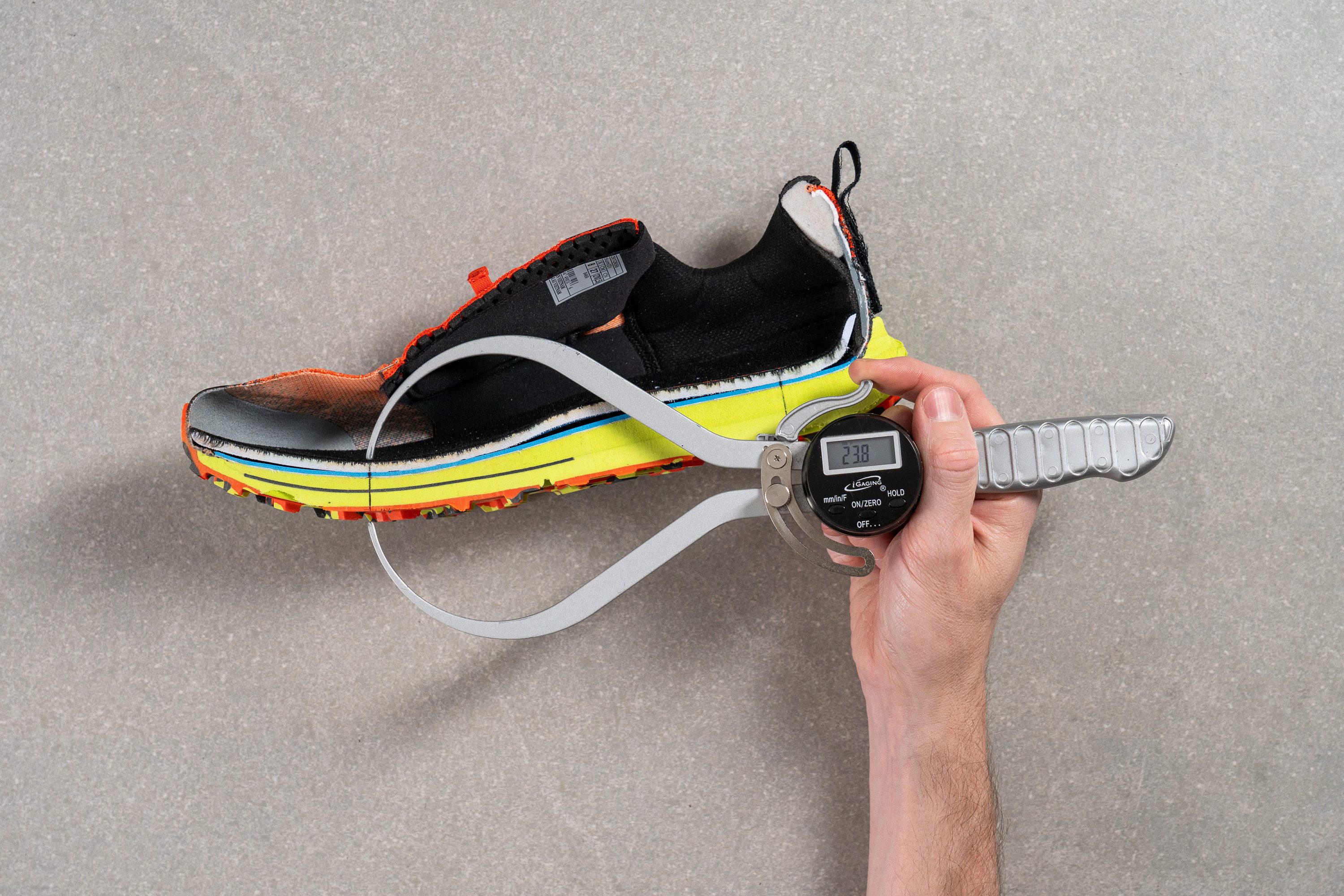
| Cascadia 18 | 23.8 mm |
| Average | 25.1 mm |
Drop
In our experience, the heel and forefoot measurements make it clear—this is a high-drop trail shoe, designed primarily for rearfoot strikers.
Forefoot and midfoot strikers will find the Cascadia comfortable, especially if they’re prone to calf or Achilles overload issues. However, many trail runners prefer lower-drop shoes, which might make this model less appealing to them.
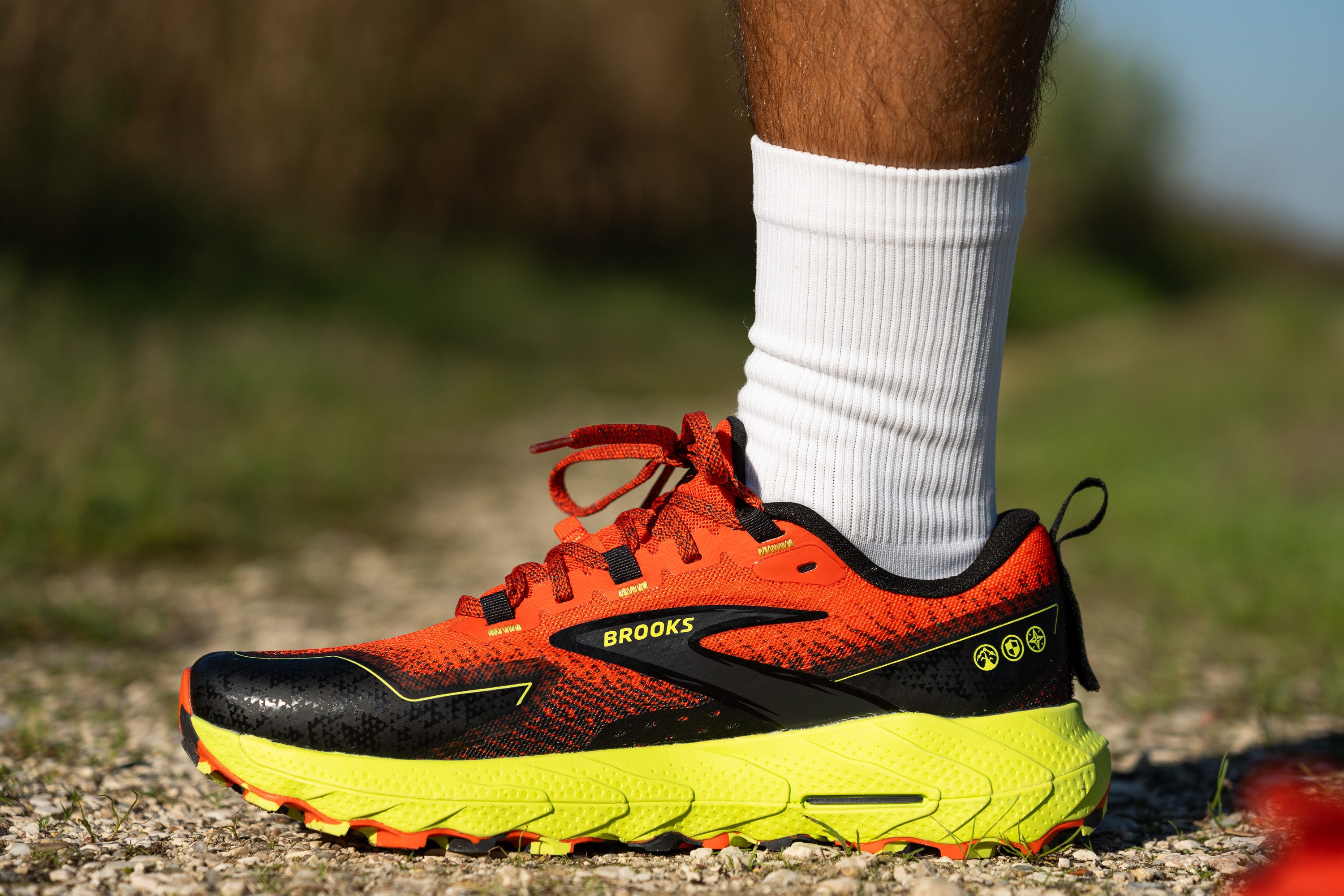
| Cascadia 18 | 8.8 mm |
| Average | 7.5 mm |
Midsole softness
One of the consistent features carried over from the previous Cascadia is the foam. We discovered the same DNA Loft v2 powering this model as well.
If you were hoping for a softer feel in this update, that’s not the case here. With a 27.5 HA reading on our durometer, we noted that this foam is even slightly firmer than its predecessor, delivering a ride that leans on the firm side.
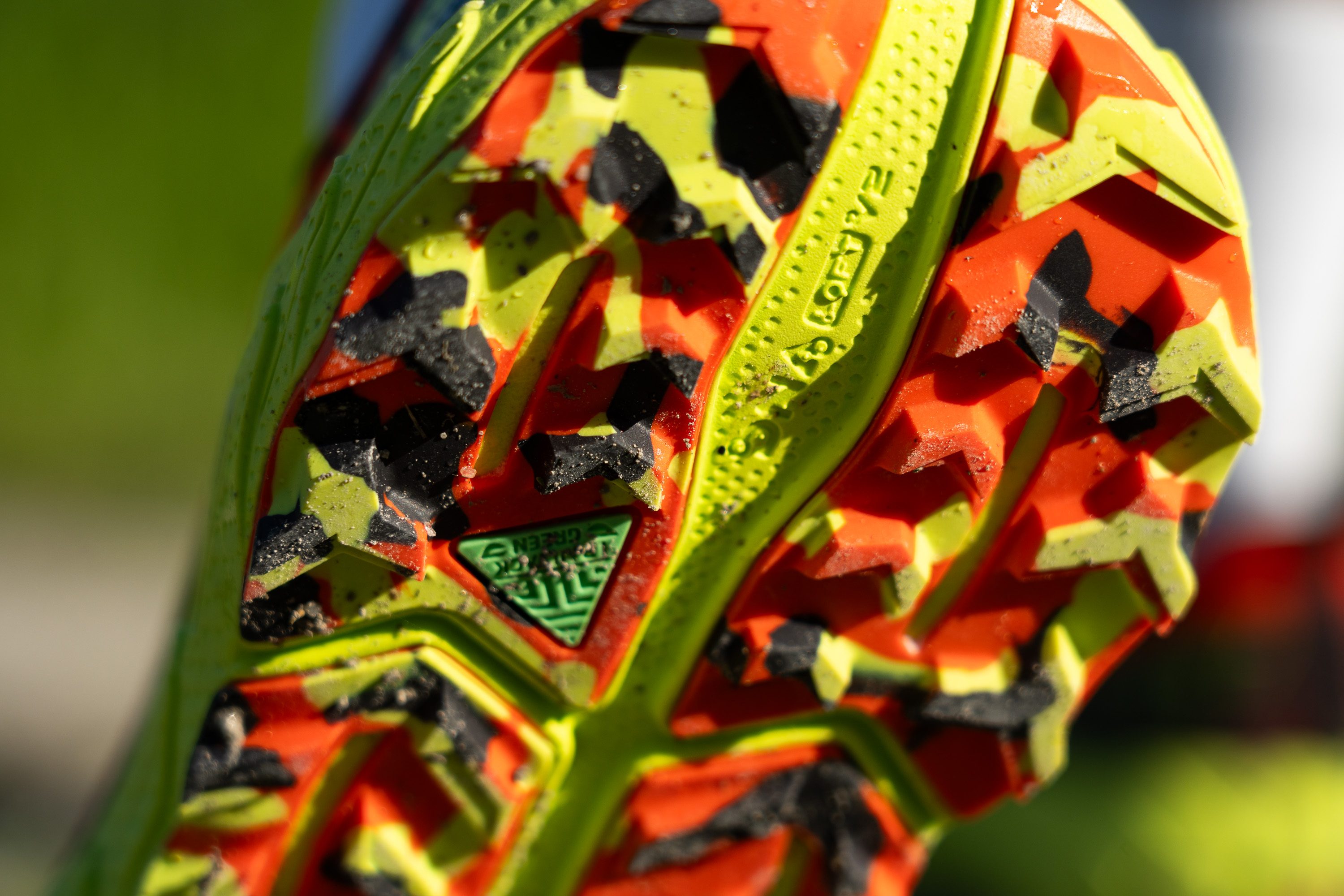
However, if you can handle that level of firmness, it offers real trail advantages—a more stable platform and better protection from sharp rocks.

| Cascadia 18 | 27.5 HA |
| Average | 21.9 HA |
Secondary foam softness
We assessed the torsional rigidity of this Cascadia 18 and assigned it a 4 out of 5. This score aligns with our expectations for a model featuring a moderate stack height combined with a rock plate. It also aligned well with our on-foot experience, as it doesn’t feel as natural or fluid as minimalist running shoes.
Rocker
The Cascadia 18 isn’t one of those extreme rockered shoes, though each year Brooks adds a bit more curve to the forefoot. This change brings some benefits and drawbacks, but we still wouldn’t classify it as a rockered shoe—especially with the heel staying very flat.
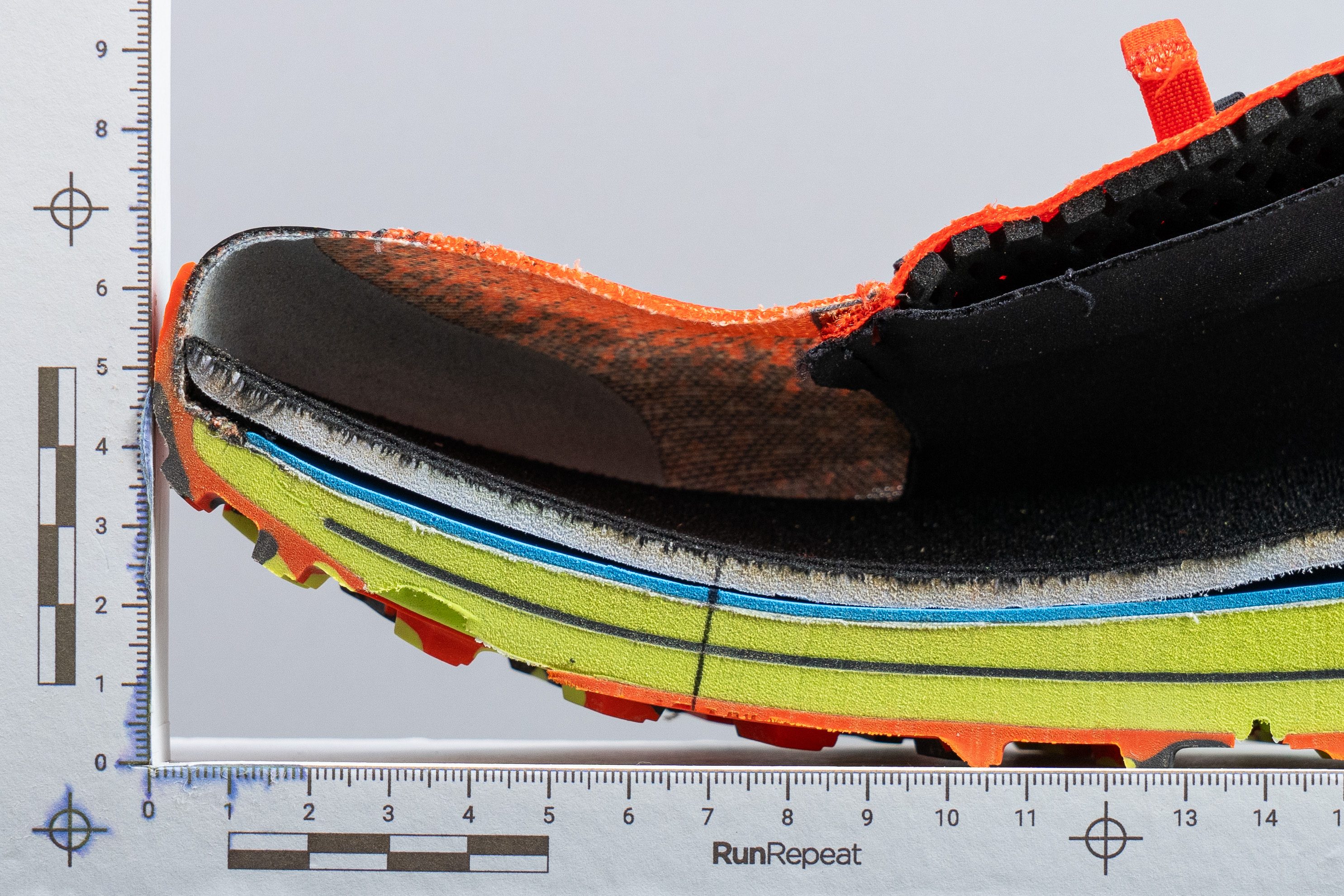
Rock plate
One standout feature that sets the Cascadia apart from most trail shoes in its category is the Trail Adapt system. This innovative setup includes a plastic plate with two heads in the heel, extending out as wings on each side of the midsole, and three fork-like heads positioned in the forefoot. Its purpose? To enhance protection against rocks and boost stability at the same time!
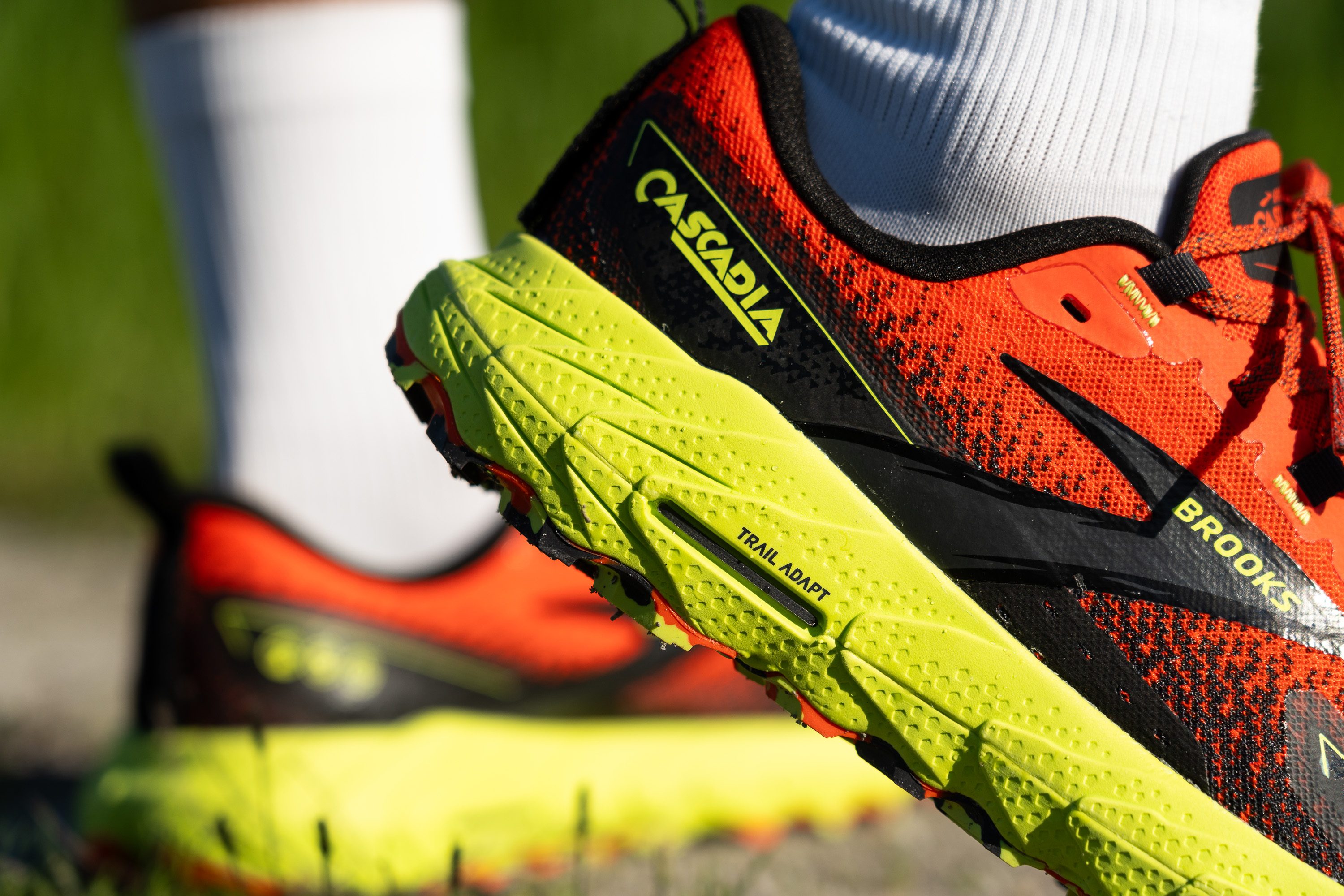
The rationale behind this design is to allow the shoe to flex torsionally, avoiding the rigidity a full-length, non-forked plate would bring, resulting in a more adaptive ride on rugged terrain.
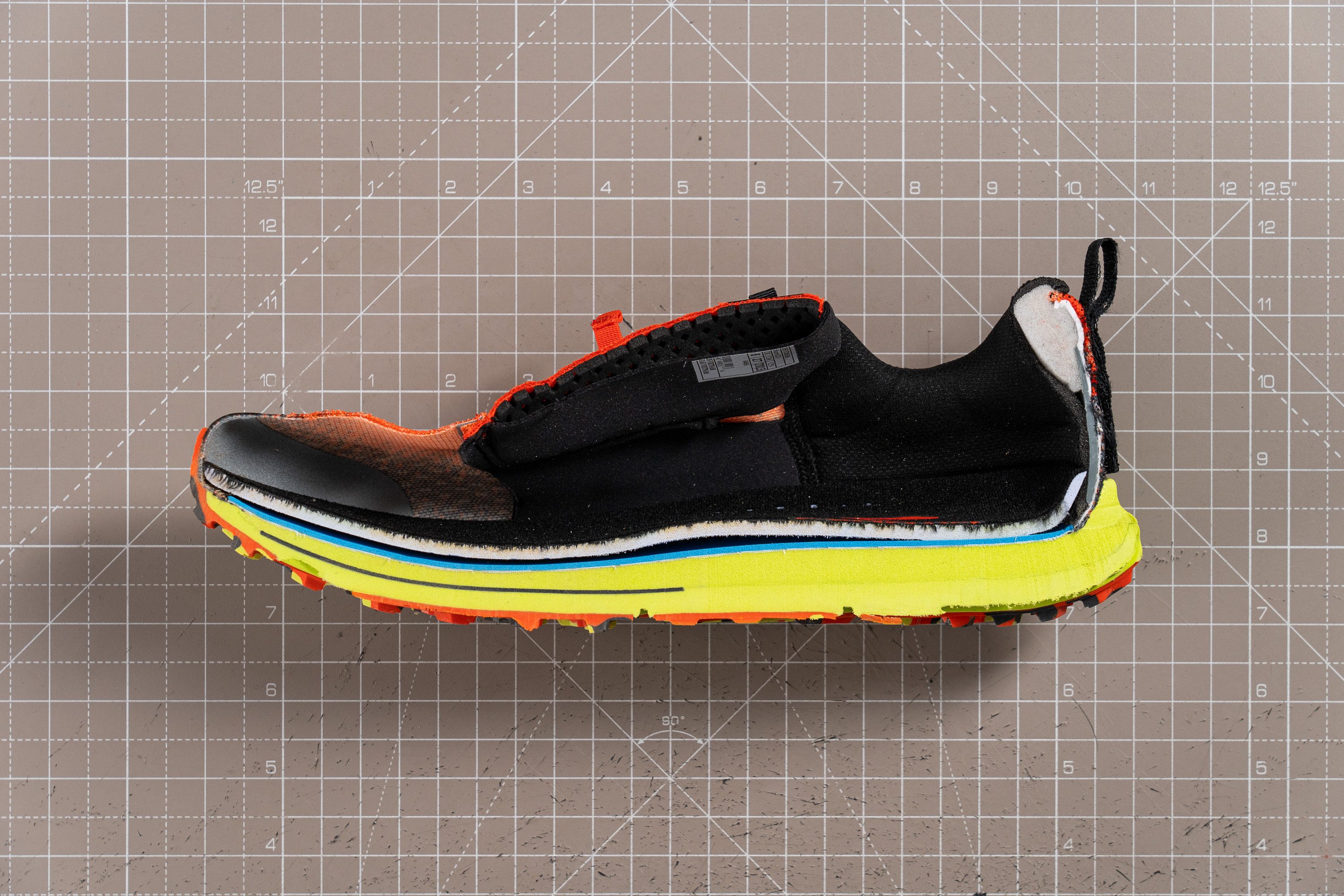
Size and fit
Size
Brooks Cascadia 18 fits true to size (154 votes).
Width / Fit
From the moment we slipped on the Cascadia 18, it felt comfortable, and it didn’t take long for us to understand why.
With a width of 97.2 mm at its widest part, the toebox is designed to deliver a dependable fit. In our view, Brooks has aimed for an easy-going, average width to accommodate as many runners as possible.
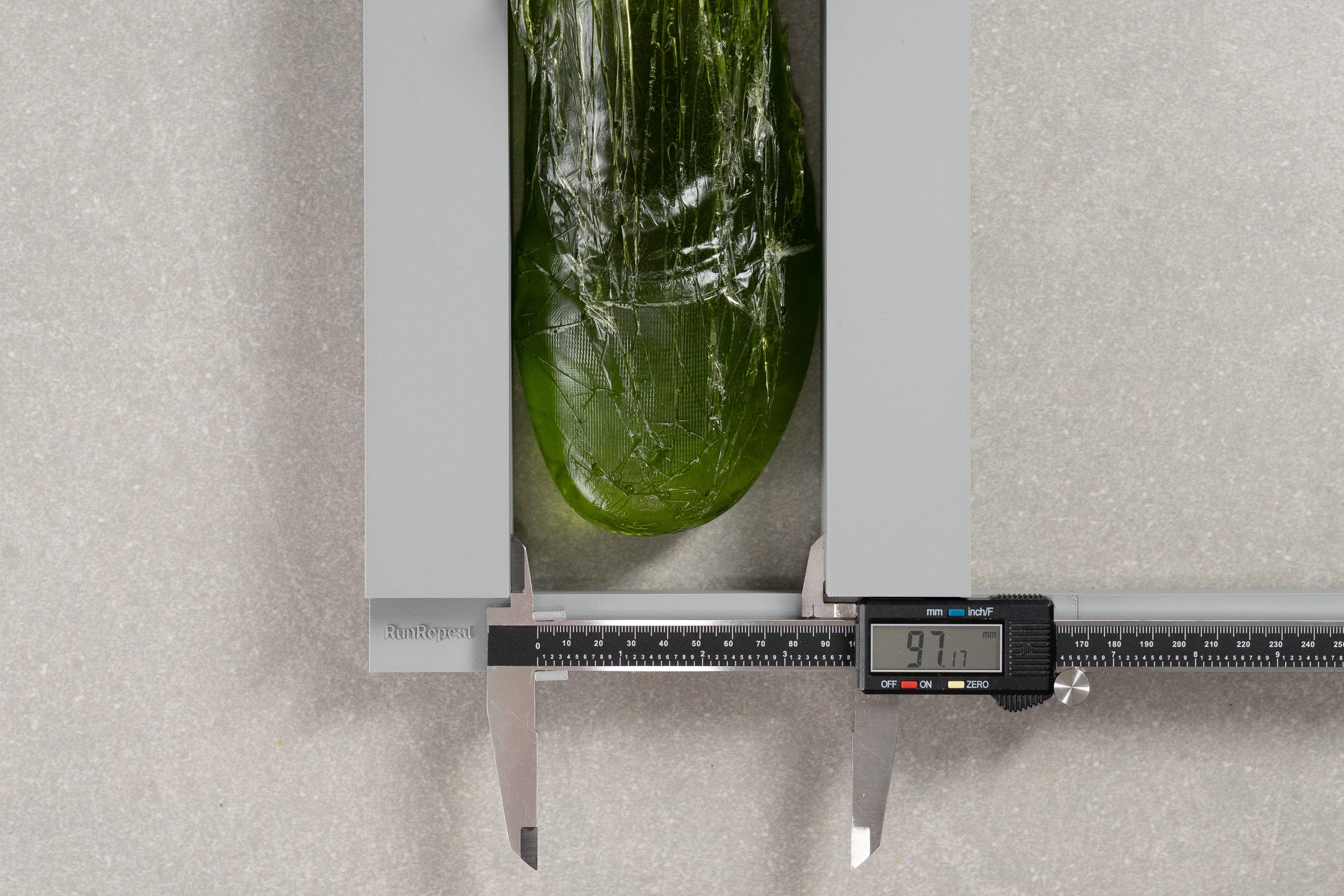
| Cascadia 18 | 97.2 mm |
| Average | 95.6 mm |
Toebox width
Our second measurement showed an 75.2 mm result—again, close to the average—suggesting that the Cascadia’s fit will appeal to most runners.

| Cascadia 18 | 75.2 mm |
| Average | 74.6 mm |
Toebox height
In terms of vertical room, we found 26.5 mm, which is enough space for natural toe movement.
That creates a non-constrictive feel ideal not only for trail running but also for long walks in nature. And if anyone needs even more room, Brooks offers a wide size option in select markets.
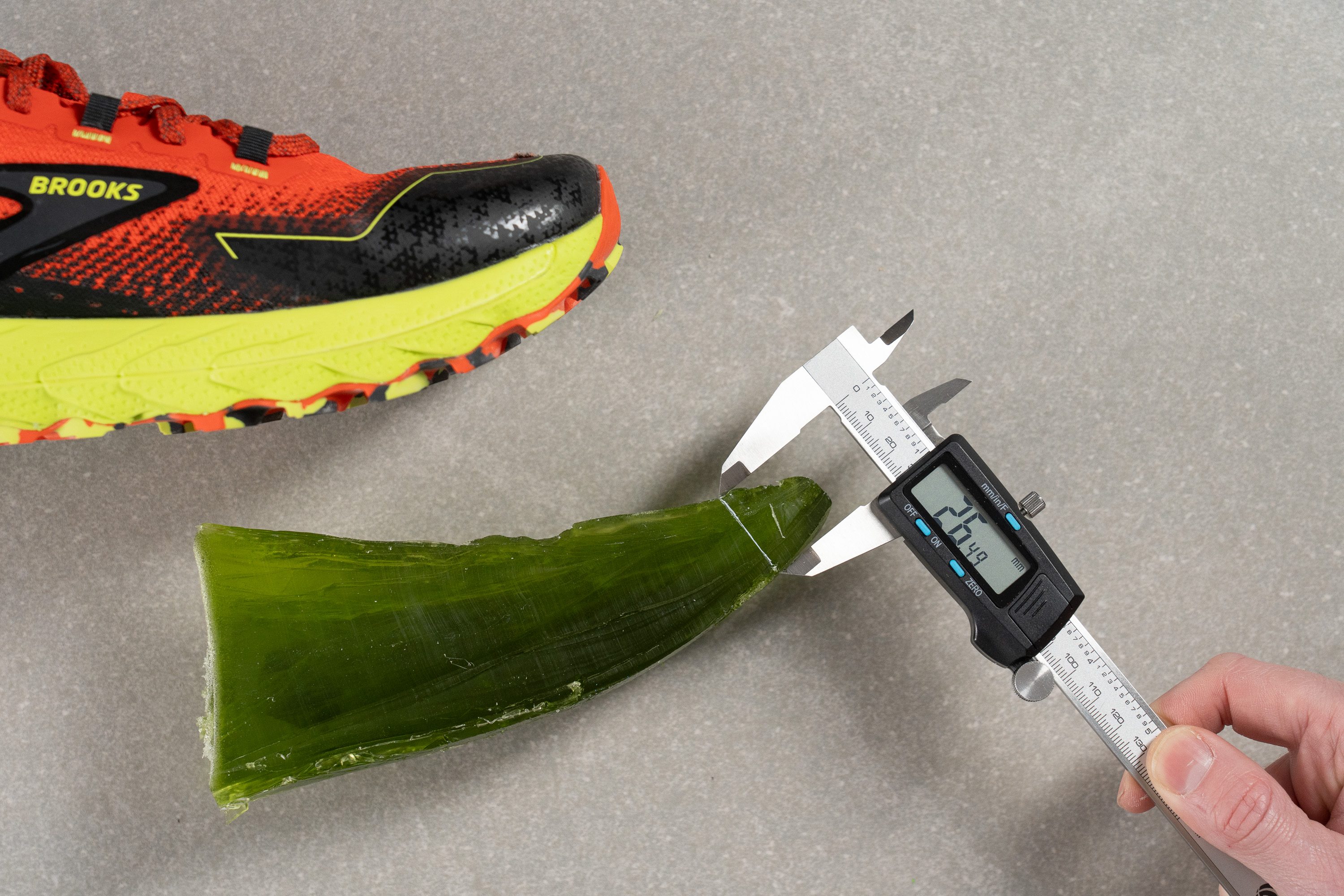
| Cascadia 18 | 26.5 mm |
| Average | 27.1 mm |
Traction / Grip
Forefoot traction
We tested the TrailTack Rubber outsole and recorded a 0.43 in our wet-grip setup. That result supports a stable-enough feel across damp forest paths or slick stones, though it leaves slight room for ultra-slick-condition improvement.
However, on dry ground the ride is really good, with that sticky sensation that makes trail running feel extra-controlled.
| Cascadia 18 | |
| Average | 0.61 |
Lug depth
The Cascadia 18 outsole remains mostly unchanged from its predecessor, which isn’t necessarily a drawback. We found that it performs reliably; while the 4.0-mm lugs aren’t quite as aggressive as industry leaders like Vibram Megagrip’s Traction Lugs, they hold their own on varied terrain.
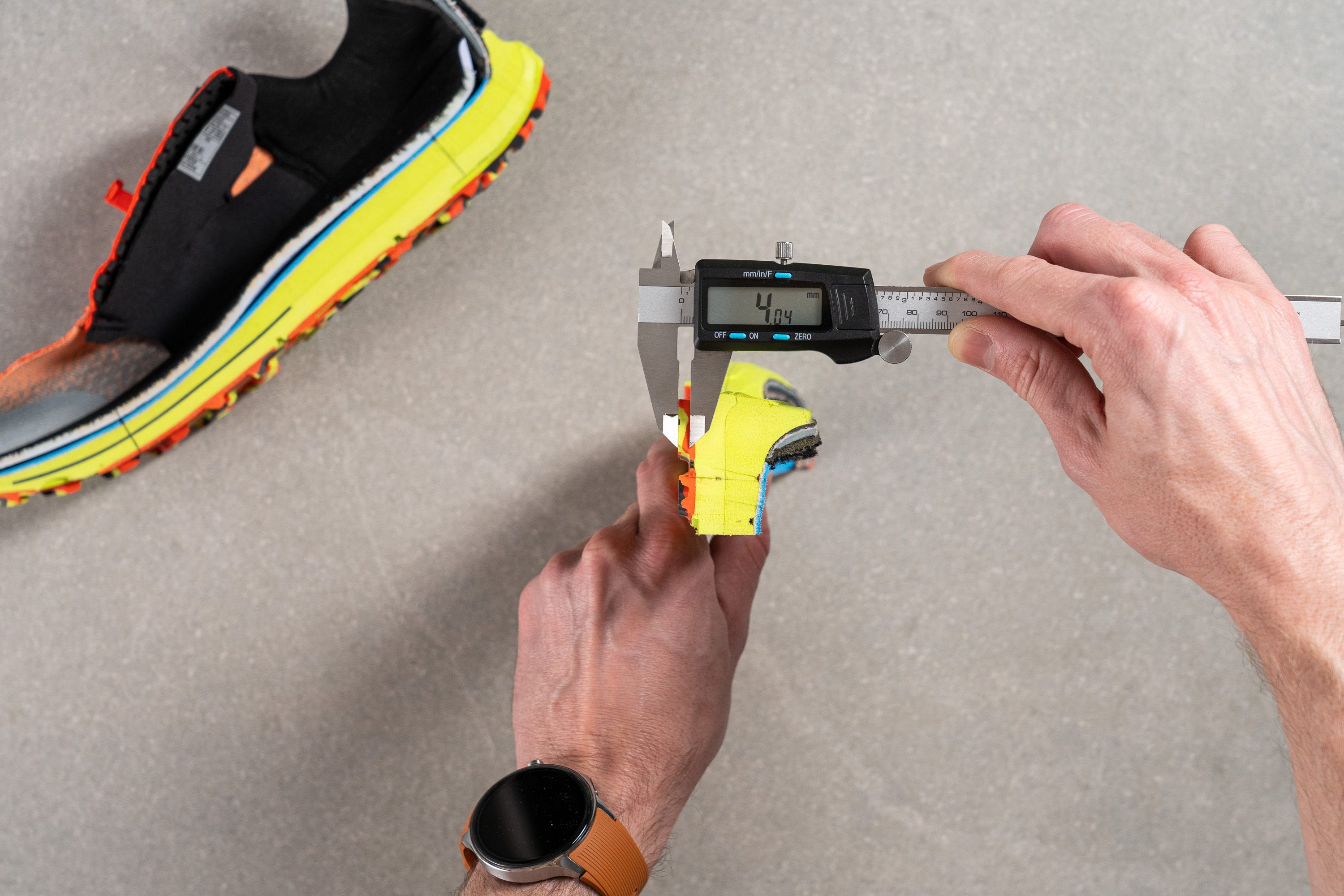
| Cascadia 18 | 4.0 mm |
| Average | 3.5 mm |
Outsole design
The Cascadia 18 outsole uses a full-length TrailTack rubber compound in a high-contrast, multicolor pattern. Despite the playful design, the lugs follow a clear three-zone layout. Heel lugs are braking-focused for downhill control. The midfoot integrates mixed, non-textured lugs that help with mud shedding, while the forefoot uses wedge-shaped lugs to assist on steep climbs.
A wide longitudinal groove runs through the centre of the outsole, flanked by two horizontal cutouts to promote natural flex and adaptability. Rubber coverage is quite good, leaving minimal exposed foam while ensuring consistent protection from heel to toe across varied terrain.
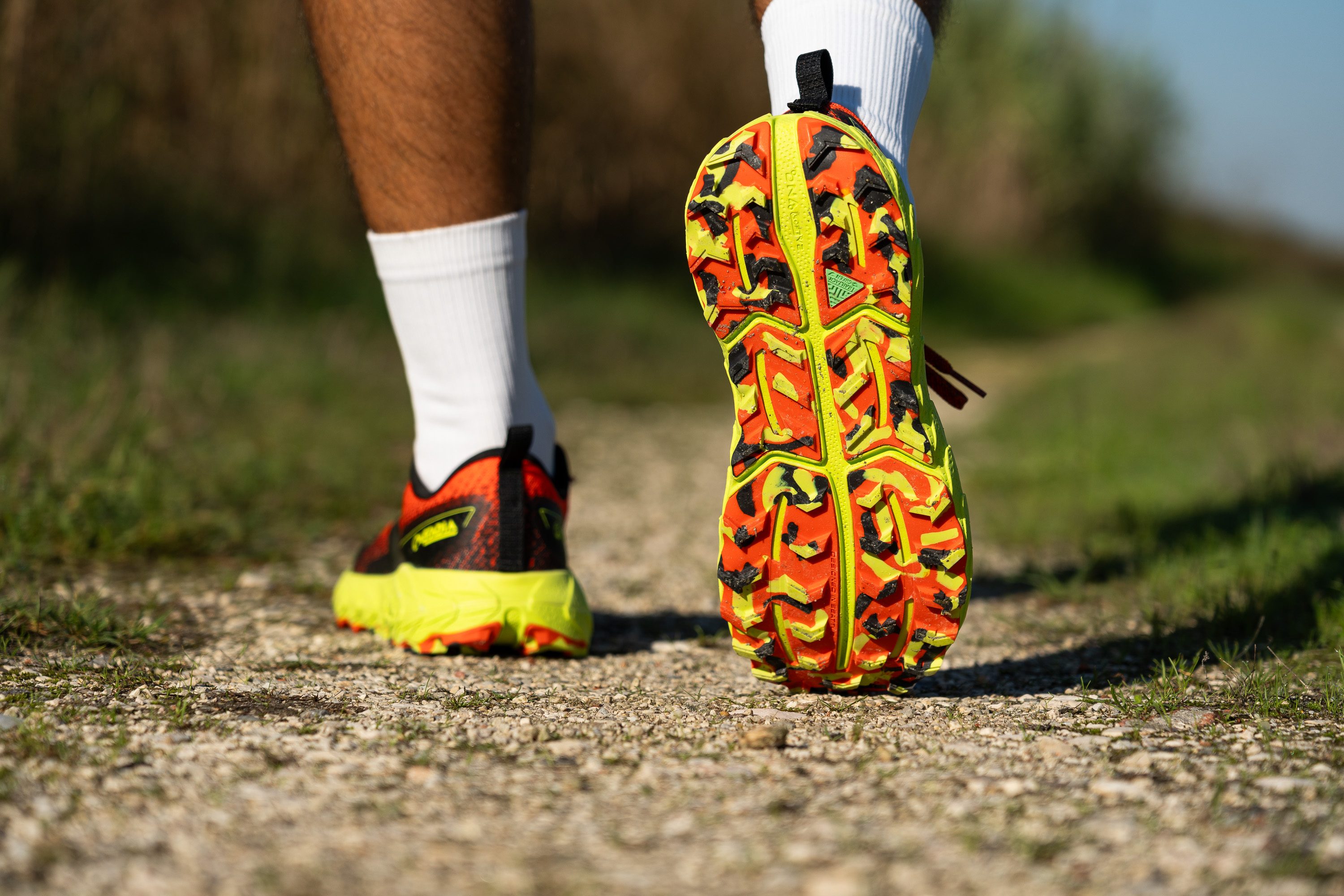
Flexibility / Stiffness
For a trail running shoe designed to double as a hiking option, maintaining a balanced level of flexibility is essential, and our custom bend test is perfect for evaluating this.
After bending the Cascadia 18 to 30 degrees, we found that it required only 17.3N of force—a somewhat average result that, in our view, offers just the right balance of flexibility for a versatile trail shoe.
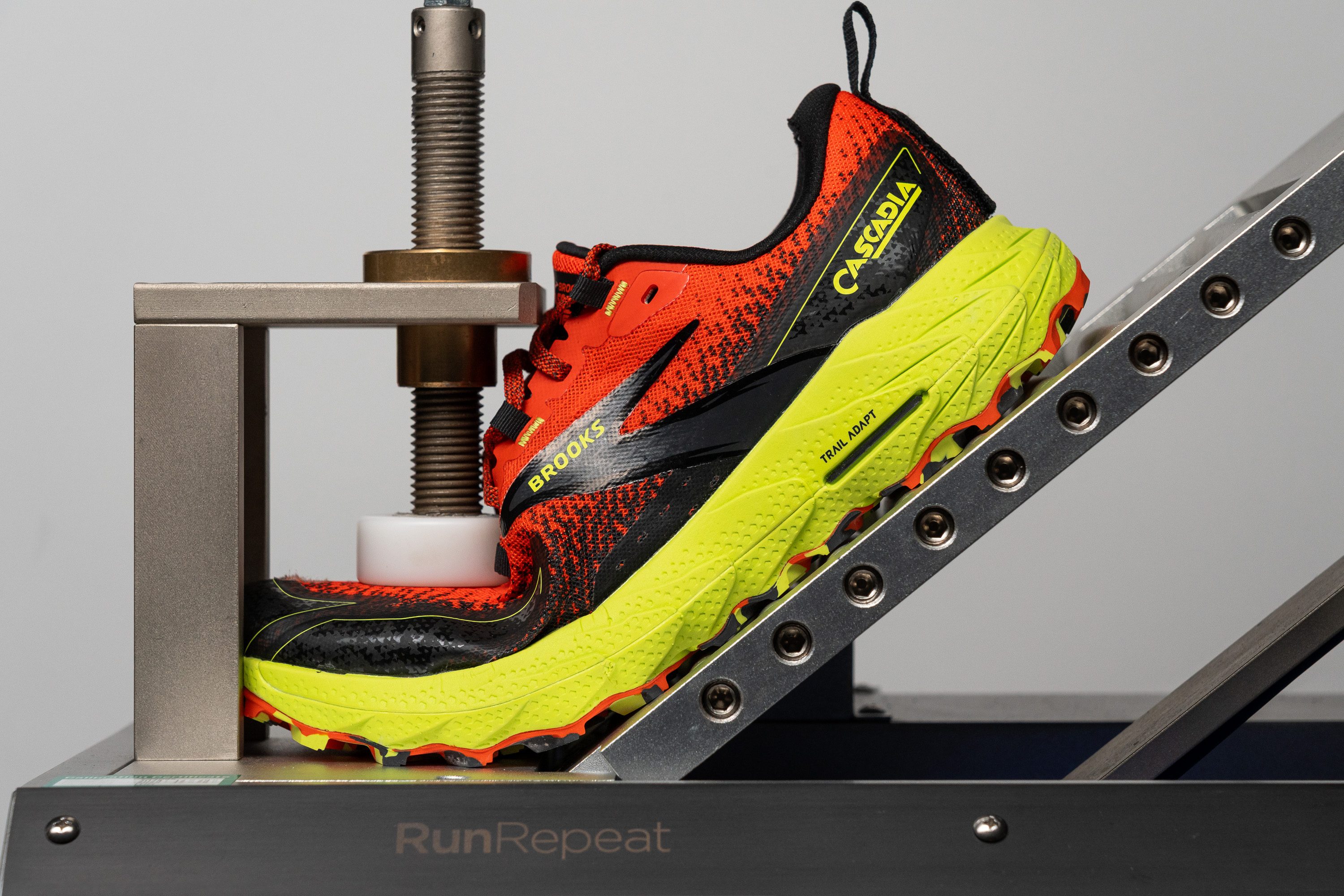
| Cascadia 18 | 17.3N |
| Average | 14.7N |
Weight
At 11.6 oz or 329g, we found the previous Cascadia to be on the heavier side—a factor we felt was among its weakest aspects.
There’s both good and bad news this time. The good news is Brooks has managed to trim it down to 10.9 oz or 310g, which is a step in the right direction. However, for a shoe with this level of cushioning, we believe it still needs to shed a bit more weight to reach a more balanced feel.

| Cascadia 18 | 10.9 oz (310g) |
| Average | 10.2 oz (289g) |
Breathability
For trail shoes, we usually prefer a balanced score regarding breathability, prioritising a bit of warmth over maximum airflow. So, we were pleased to find a 4/5 rating here instead of an overly ventilated 5/5.
Brooks has crafted a lightweight, thin engineered mesh for this shoe, thoughtfully pairing it with other fabrics tailored to specific areas. For instance, the heel and midfoot are generously padded, yet ventilation in these sections is minimal, as expected for added comfort and durability.
We were surprised because Brooks included a perforated insole—an impressive feature that’s more common in premium running shoes. It’s a clever touch, offering a touch of extra ventilation.
When examining the upper under the microscope, we noticed the mesh's thin construction, which raised some durability concerns for us in the lab, as it may wear down quickly against our Dremel test.
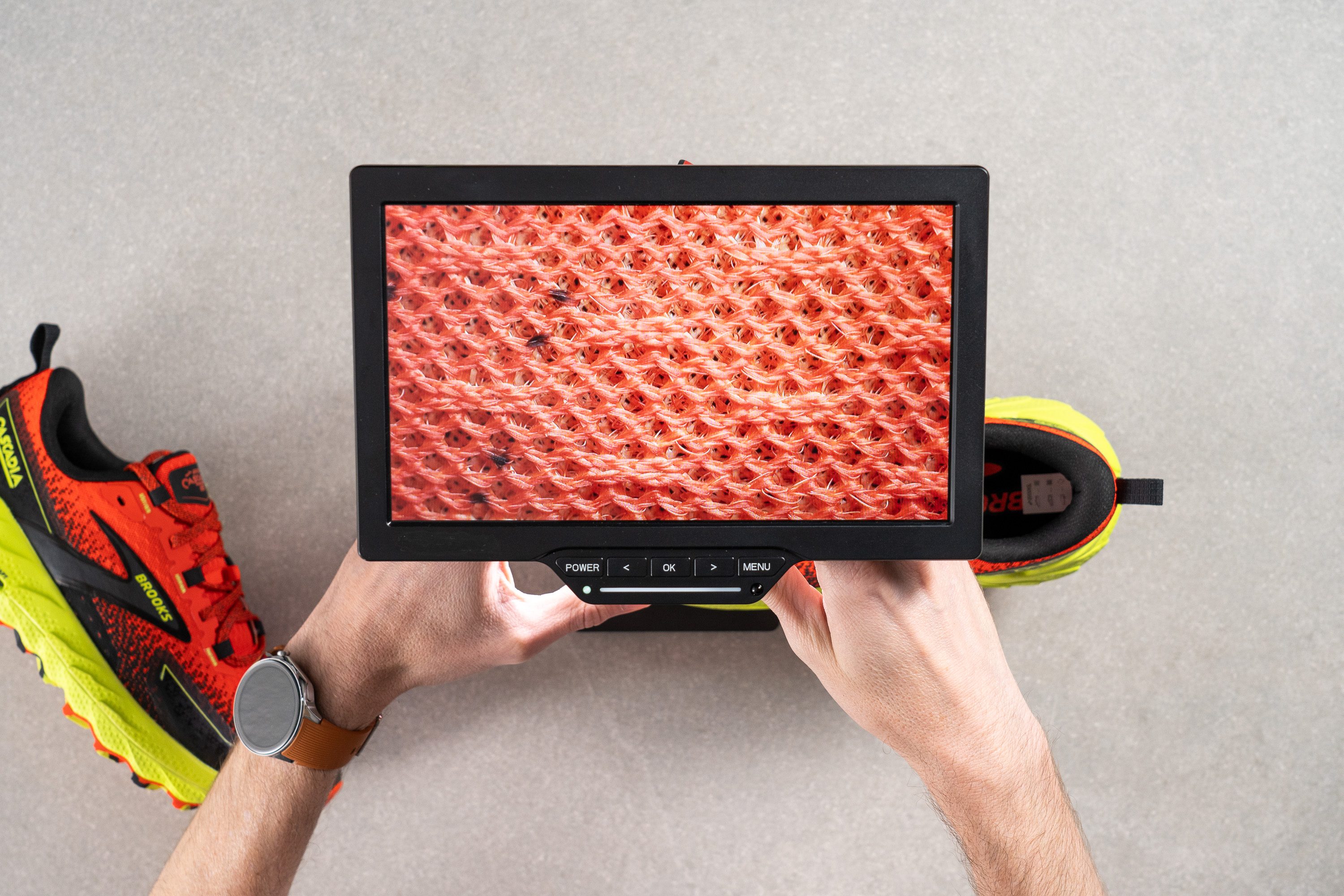
However, before testing abrasion, we evaluated the upper’s structure.
Overall, it’s well-designed for a trail shoe, with rugged thermoplastic overlays protecting high-wear areas like the toe cap and sufficient padding to support a comfortable fit.
| Cascadia 18 | 4 |
| Average | 3.2 |
Stability
Lateral stability test
In our experience, the Cascadia 18 stands out for those who need a trail shoe that balances top stability with versatility across various surfaces. Furthermore, we found it particularly well-suited for heel strikers, offering dependable traction and control.
Torsional rigidity
We assessed the torsional rigidity of this Cascadia 18 and assigned it a 4 out of 5. This score aligns with our expectations for a model featuring a moderate stack height combined with a rock plate. It also aligned well with our on-foot experience, as it doesn’t feel as natural or fluid as minimalist running shoes.
| Cascadia 18 | 4 |
| Average | 3.6 |
Heel counter stiffness
Throughout this lab review, we’re consistently finding that this shoe is geared towards heel strikers, and here’s more solid proof. Scoring a full 5/5 in our heel counter stiffness test, it delivers unmatched stability in this area. However, the ultra-stiff heel might feel somewhat clunky or uncomfortable for certain runners—especially those with sensitive Achilles tendons.
For those needing a more comfortable counter in a dependable trail shoe, we suggest considering the ASICS Gel Trabuco 12.
| Cascadia 18 | 5 |
| Average | 3 |
Midsole width - forefoot
The midsole carries over largely unchanged from its predecessor at 112.6 mm, offering a standard design. However, we found the midfoot area to be notably broad, enhancing stability—particularly beneficial for maintaining control on descents.
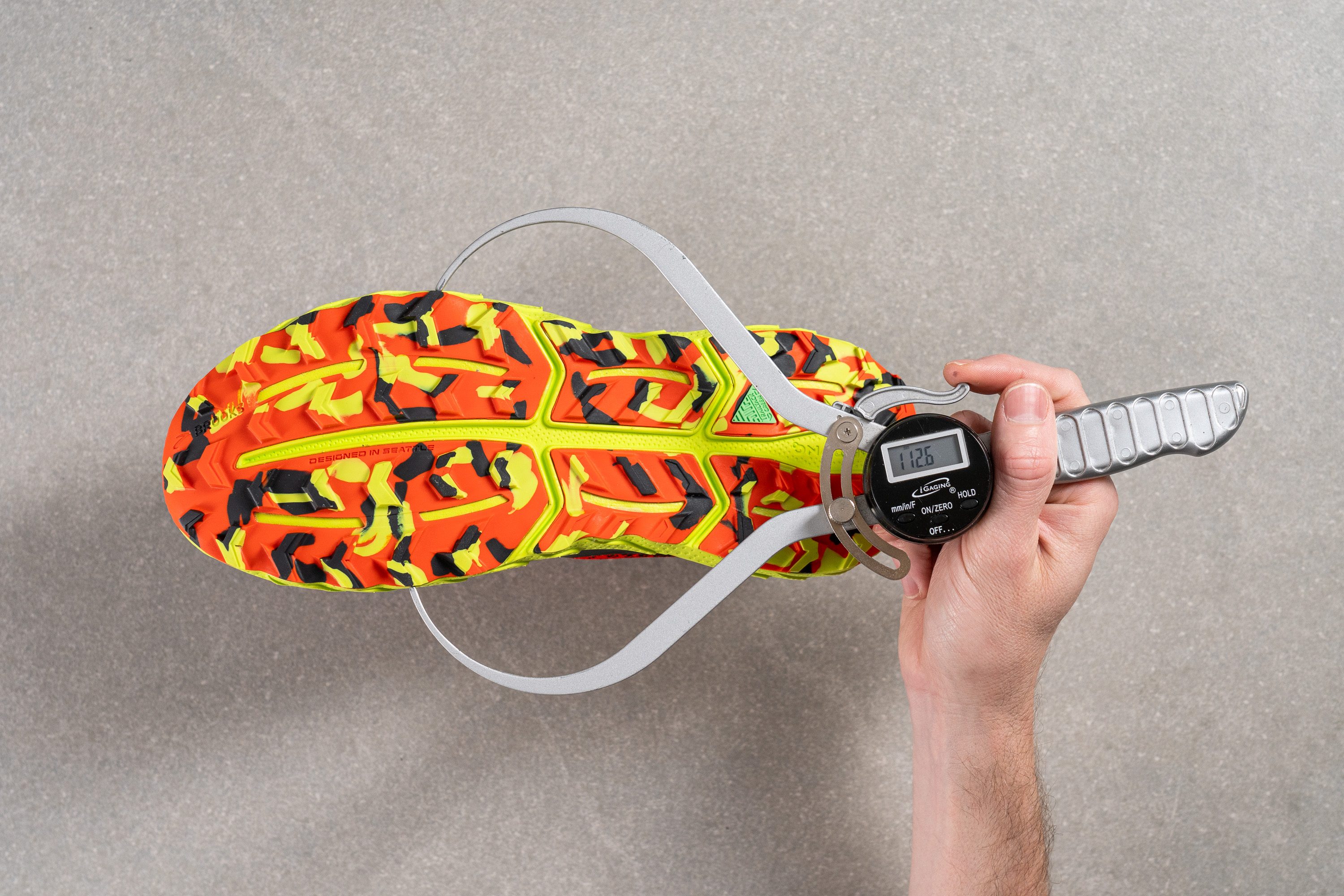
| Cascadia 18 | 112.6 mm |
| Average | 112.8 mm |
Midsole width - heel
In our experience, as highlighted throughout this review, it’s clear Brooks designed the Cascadia 18 with heel strikers in mind. We found the rear section significantly broader than average—measuring an impressive 95.6 mm under our calipers—which enhances stability for heel strikers.
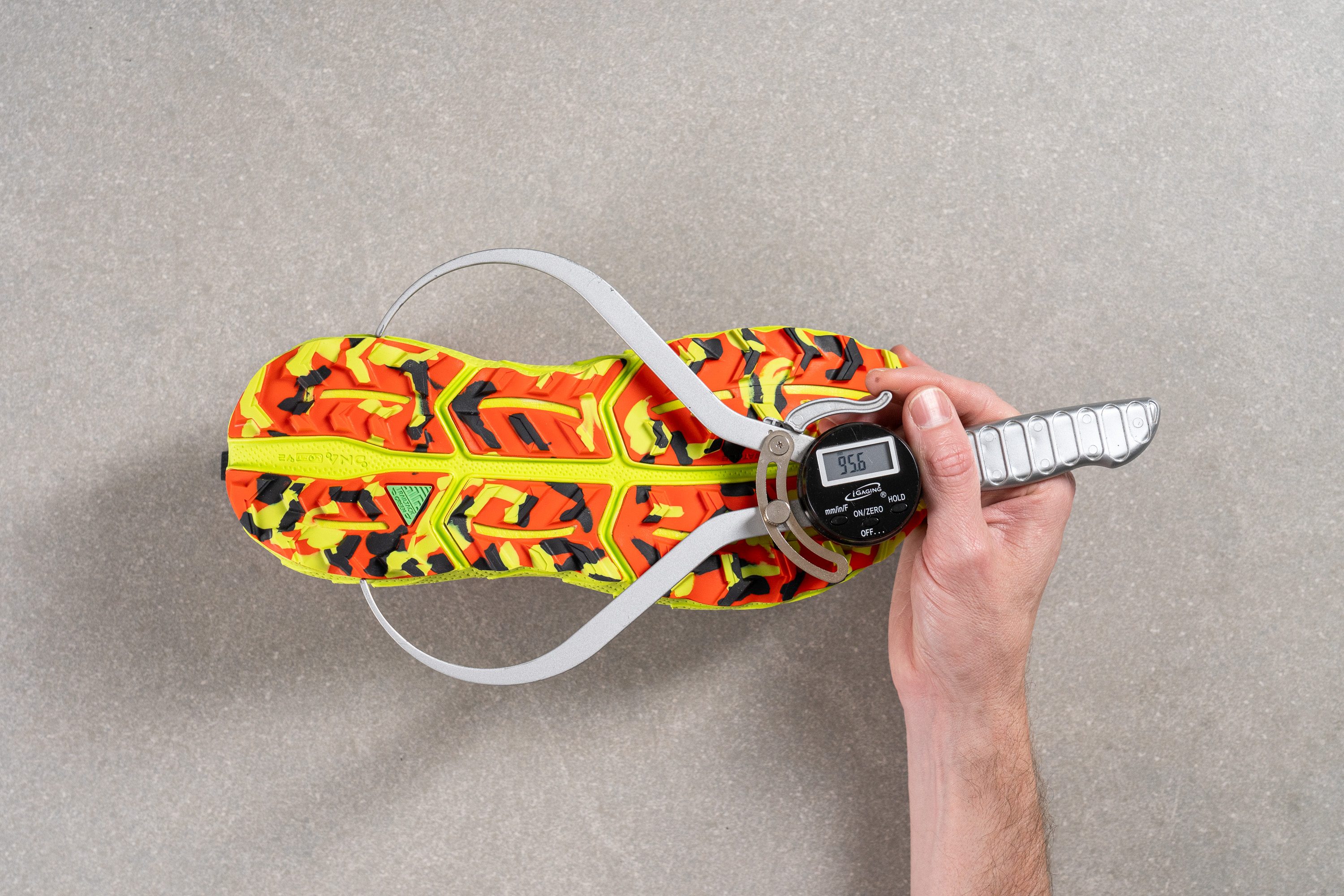
| Cascadia 18 | 95.6 mm |
| Average | 89.9 mm |
Durability
Toebox durability
After testing hundreds of shoes in the lab, we usually have a sense of how they’ll perform under rigorous testing. Unfortunately, things didn’t look promising for the Cascadia 18 in this round.
The thin engineered mesh failed to showcase any noticeable damage resistance. Of course, had we conducted the test on the thermoplastic overlay protecting the toe cap, the results would have been different. But we already know that TPU excels in durability; our aim was to assess the vulnerability of the rest of the toebox. And, based on our findings, that's a 1 out of 5 for us.
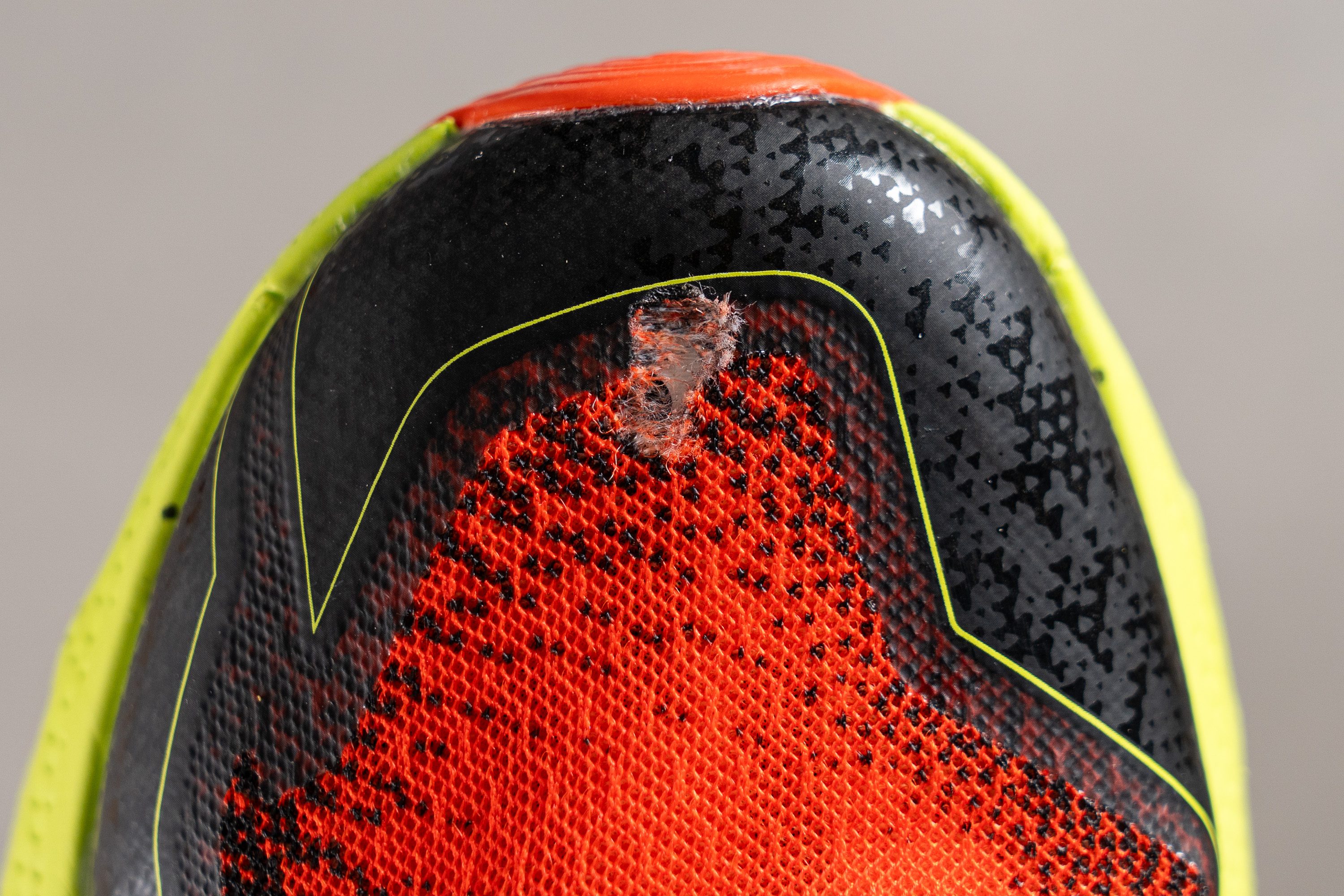
| Cascadia 18 | 1 |
| Average | 3.1 |
Heel padding durability
The upside of receiving a 1/5 score is that the Cascadia can only go up from there. Although the heel padding scored a slightly improved 2/5, we found it still disappointing, as it's still far away from most trail shoes.
In our view, Brooks must address this issue for the next Cascadia iteration. These low durability scores raise concerns, especially for runners prone to wearing out the toebox or Achilles area.

| Cascadia 18 | 2 |
| Average | 3 |
Outsole hardness
If there’s one component we closely inspect in trail running shoes, it’s the outsole. So, let’s dive into the TrailTack Green rubber—carried over from the previous Cascadia due to its impressive traction on multiple surfaces, which we confirmed again with this model.
We tested its hardness using our Shore C durometer and obtained an 84.5 HC score. This result aligns closely with the average trail shoe, maintaining a balanced level of hardness—right where most trail outsoles fall in our lab tests.
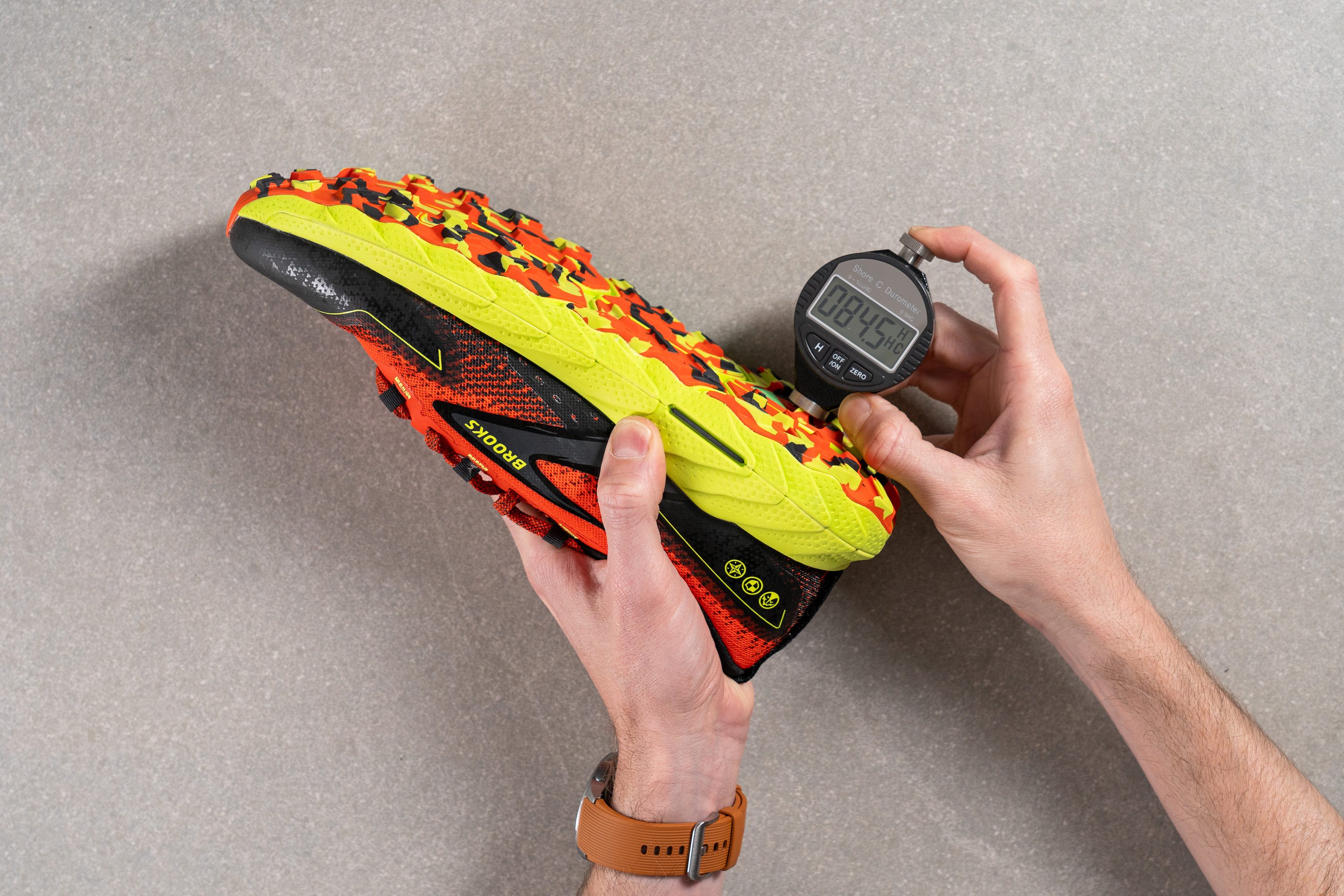
| Cascadia 18 | 84.5 HC |
| Average | 85.8 HC |
Outsole durability
But, what about durability? Our first two tests were genuinely disappointing, so we hoped this one would fare better—a third negative result would be a serious setback.
After lifting the Dremel and using a tyre tread gauge to measure, we recorded 1.3 mm of wear. While it didn’t reach our ideal standards, we found the result to be manageable rather than disastrous.
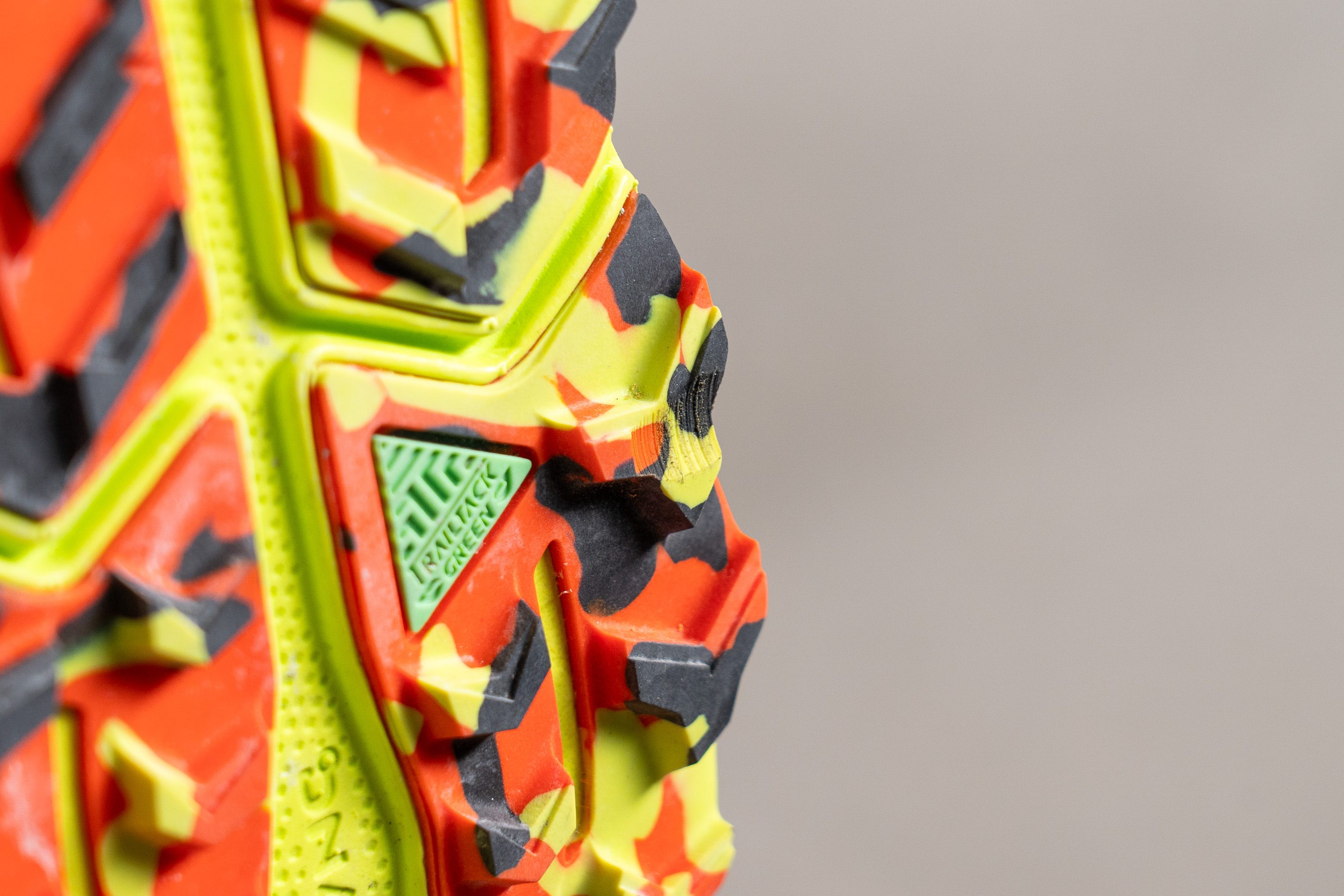
| Cascadia 18 | 1.3 mm |
| Average | 0.9 mm |
Outsole thickness
The outsole packs a solid 2.0 mm of durable rubber—definitely built to withstand the miles and protect the midsole from sharp rocks.
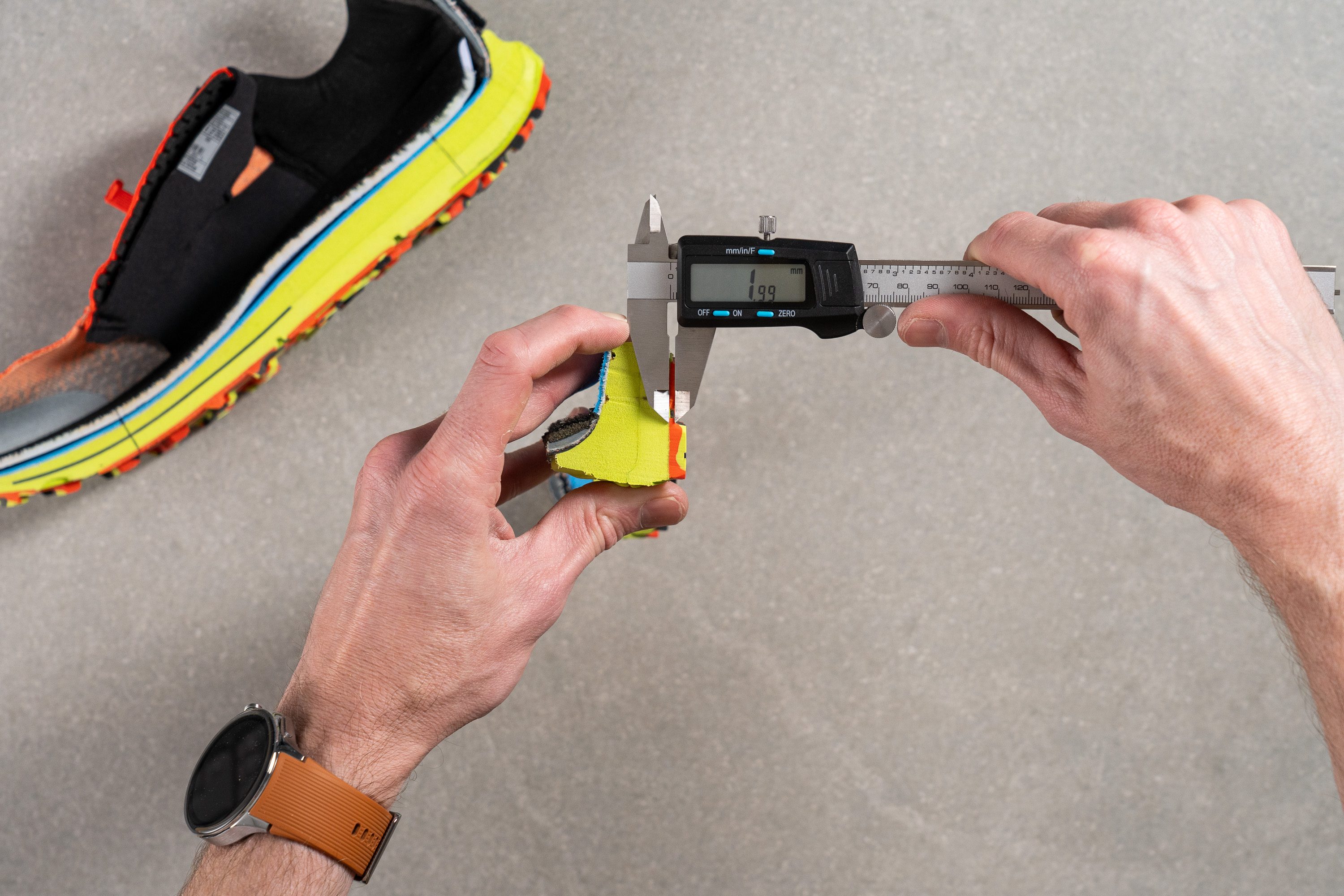
| Cascadia 18 | 2.0 mm |
| Average | 2.2 mm |
Misc
Insole thickness
We found the insole to be comfy, offering a balanced feel underfoot. Measuring at 5.1 mm, it sits close to the average thickness for insoles in all running shoes.
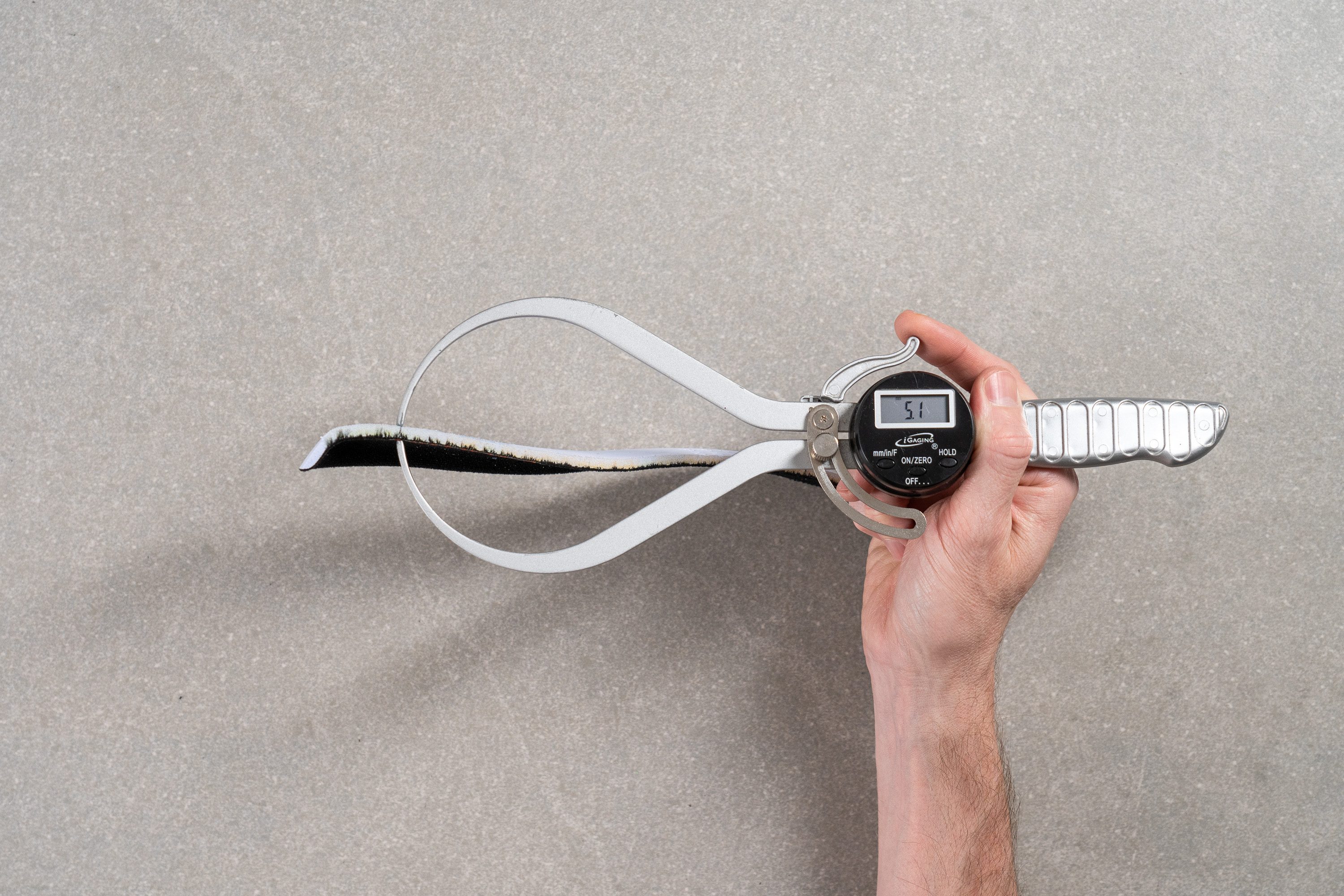
| Cascadia 18 | 5.1 mm |
| Average | 4.7 mm |
Removable insole
The insole of the Cascadia 18 is removable, allowing you to swap in a third-party option if desired. However, doing so means losing one of this shoe’s standout features—a perforated insole designed for enhanced airflow.

As we confirmed in our breathability assessment at the start of this lab review, this unique ventilation element sets the Cascadia 18 apart from many competitors by providing improved cooling during runs.
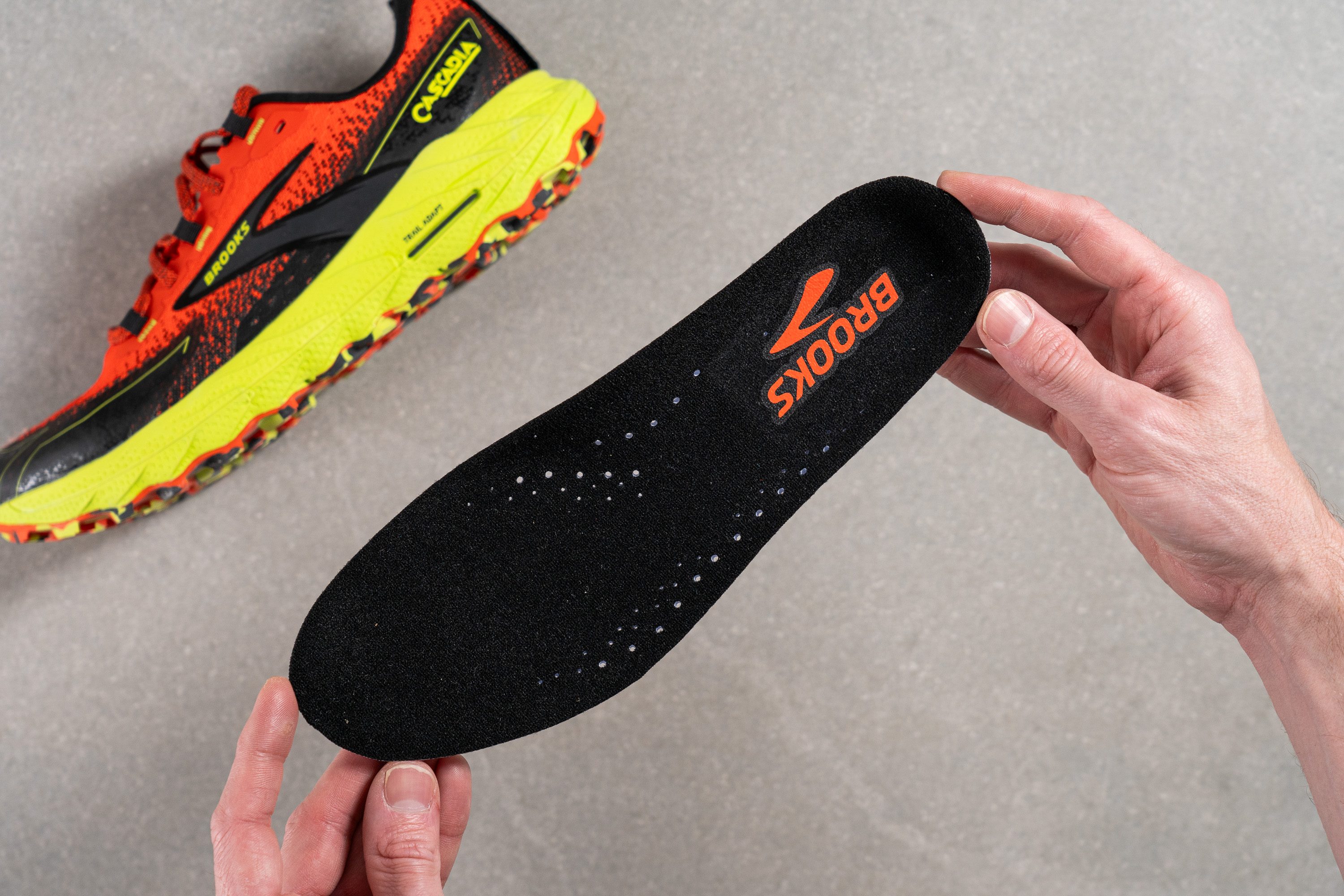
| Cascadia 18 | Yes |
Midsole softness in cold (%)
In our testing, DNA Loft v2 impressed us with its resilience for being an EVA-based foam.
We put the Cascadia 18 in the freezer for 20 minutes and re-measured its softness. After exposure, it only became 12.7% firmer, which is an outstanding result for cold-weather performance.
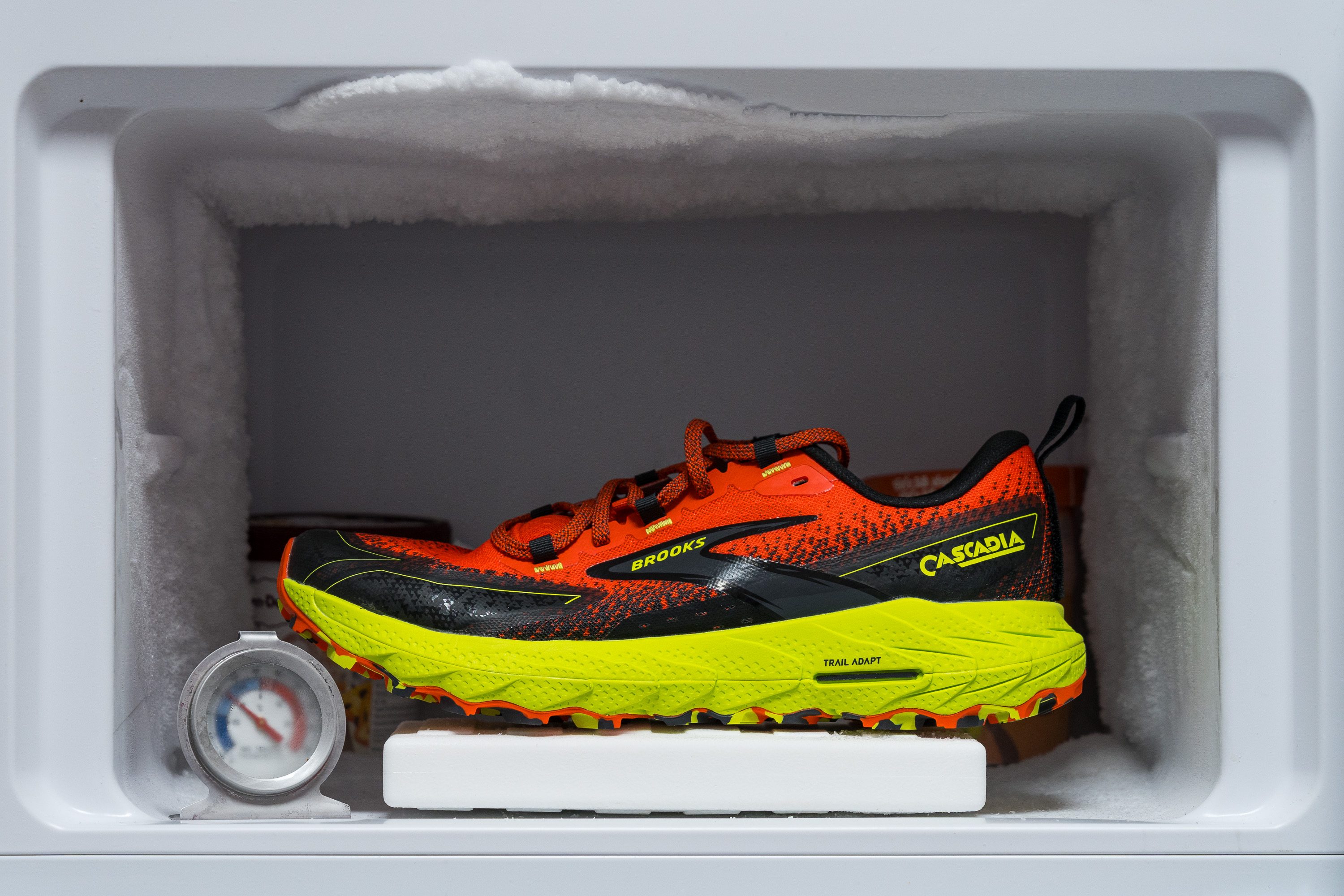
| Cascadia 18 | 13% |
| Average | 26% |
Reflective elements
In our review of the Cascadia 17, we had hoped the 18th edition would finally include reflective elements for better safety. However, that update didn't arrive. For this reason, one of this model’s most notable drawbacks is its complete lack of reflective details. Again.
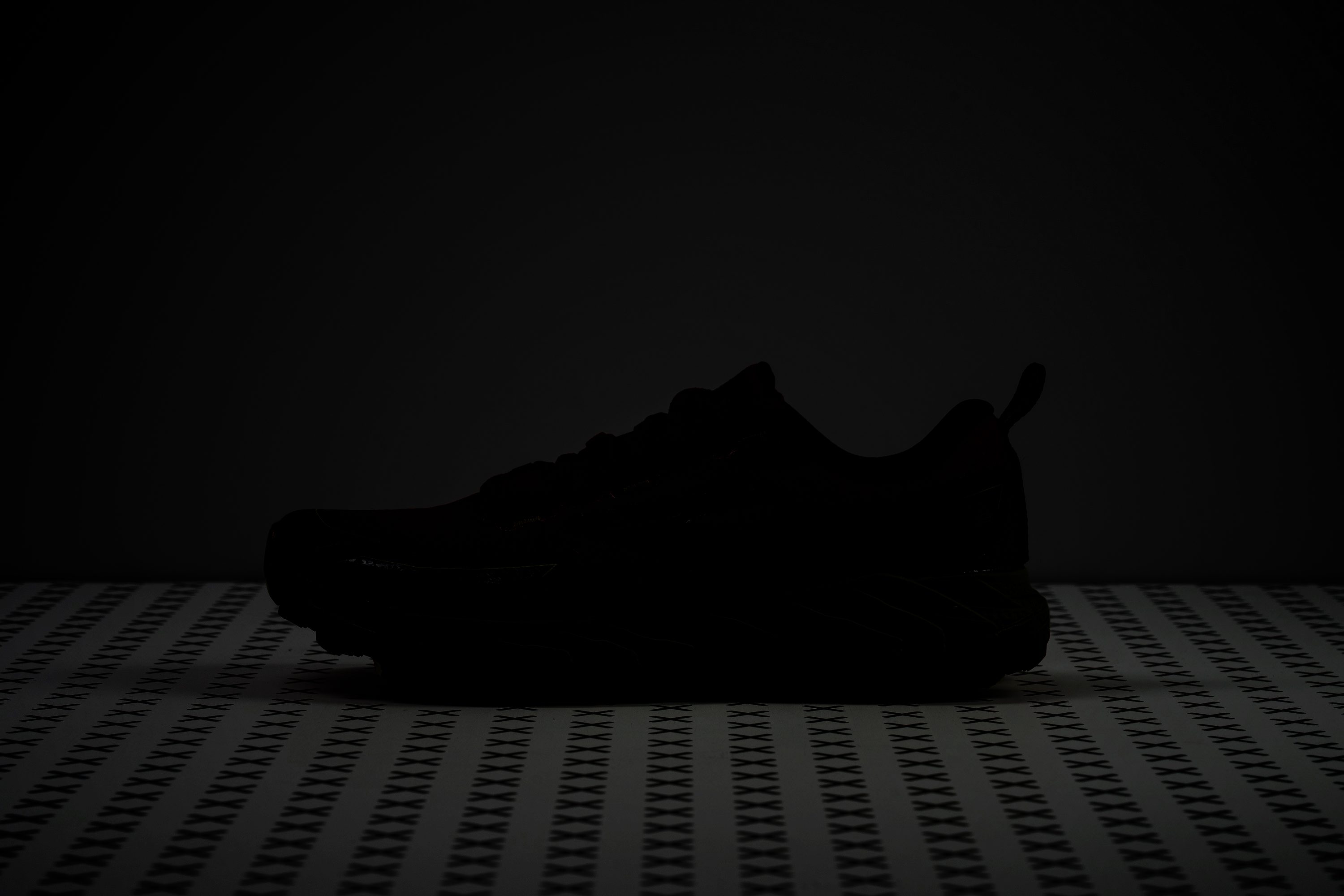
| Cascadia 18 | No |
Tongue padding
The tongue thickness was one of the big changes from the Cascadia 16 (12.2 mm) to the Cascadia 17 (4.7 mm). And it seems that Brooks found, as we did, this approach better as the newly updated tongue was very similar at 5.5 mm.

The lacing system has also been redesigned, now featuring three lace loops and three punched eyelets. We’re not thrilled with this update—punched eyelets, in our experience, tend to be more convenient and durable, especially when tightening the laces under high tension.

| Cascadia 18 | 5.5 mm |
| Average | 6.4 mm |
Tongue: gusset type
One standout feature of the Cascadia 18—especially for its price—is its gusseted tongue, which attaches securely to the sides. We've noted that this design effectively keeps out debris and provides an enhanced, secure lockdown.

| Cascadia 18 | Both sides (semi) |
Price
In recent years, we’ve become accustomed to small price hikes across many models, yet Brooks decided to hold the line with the Cascadia 18’s retail price. In our view, this decision is a wonderful choice, as we believe this trail shoe offers solid value without breaking the bank.
| Cascadia 18 | $140 |
Heel tab
The Cascadia 18 retains its classic finger-loop heel tab—an appreciated detail from its predecessors that, in our experience, adds real value to any trail shoe...and looks fantastic too!
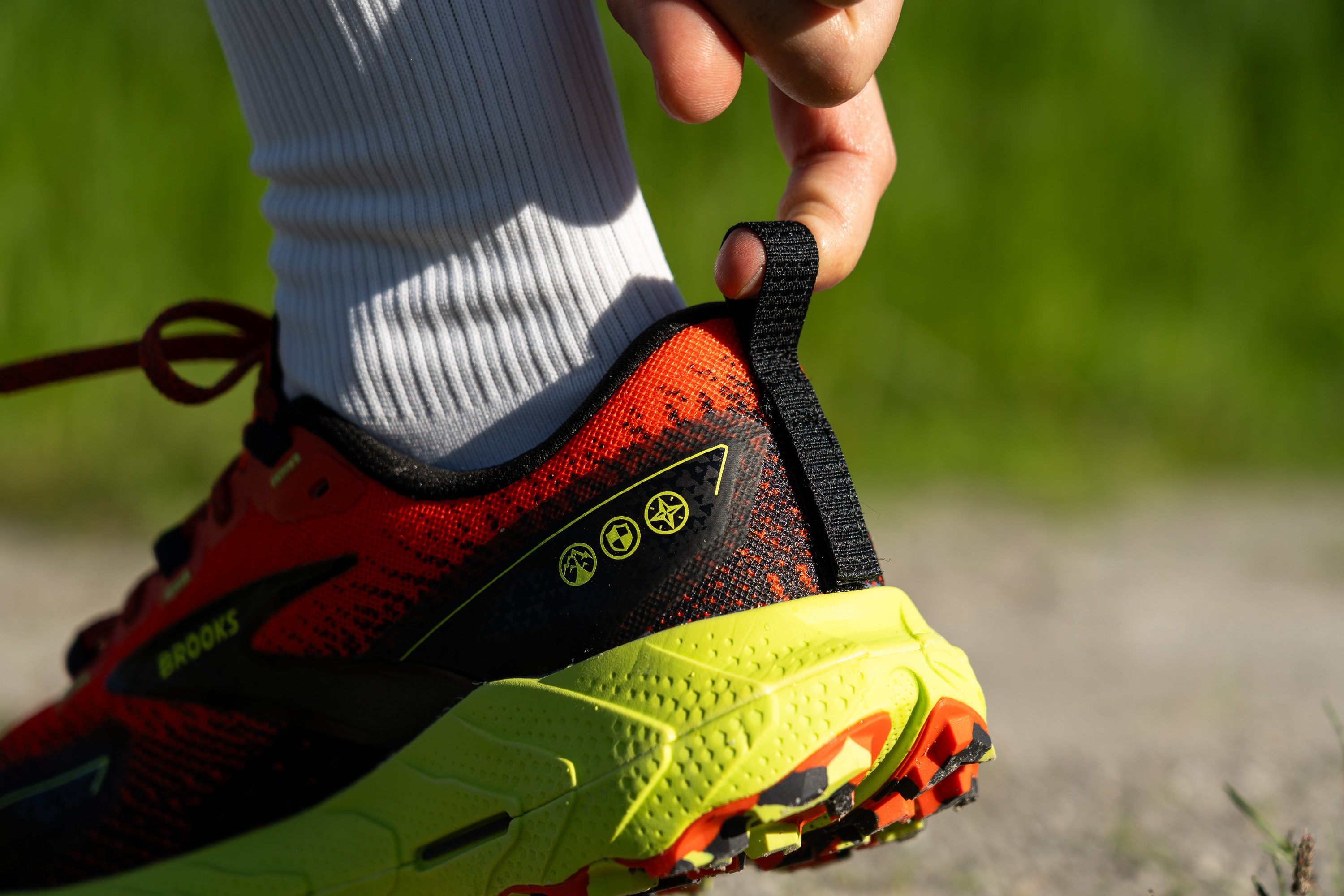
| Cascadia 18 | Finger loop |
Tongue strap
One of the more frustrating aspects for trail runners is dealing with loose laces. Thankfully, we found that Brooks has added a convenient elastic strap on the tongue—perfect for tucking the laces securely before heading out for a run and keeping them out of the way.
Velcro strap
We noted that Brooks has once again included a Velcro strap on the heel counter for attaching gaiters, which, of course, are sold separately from the shoe.

